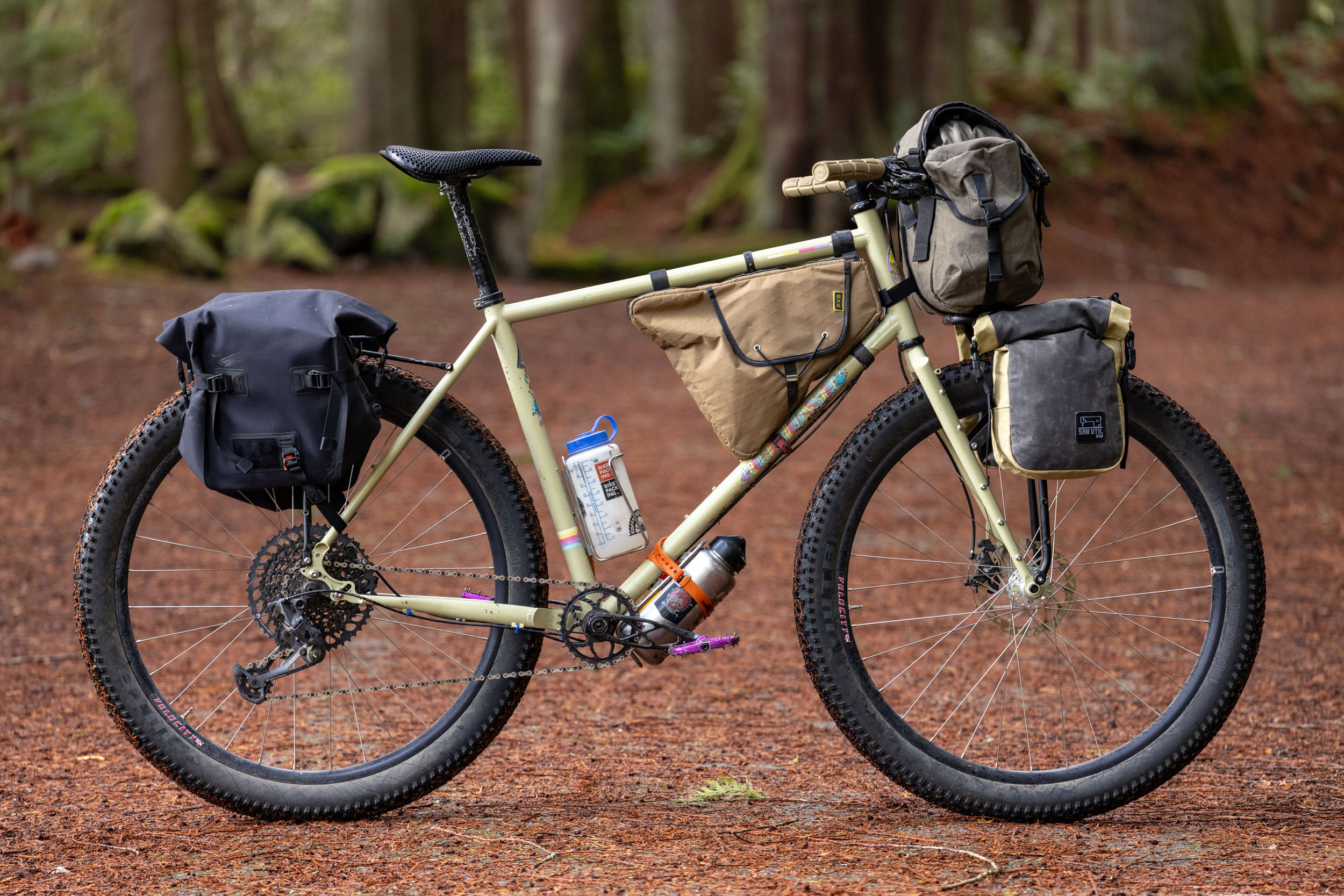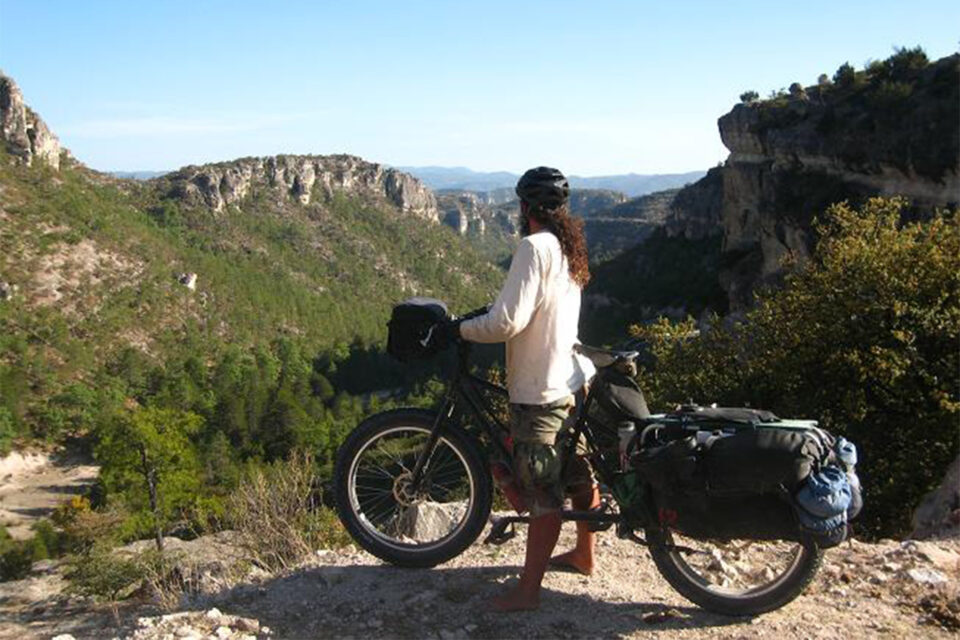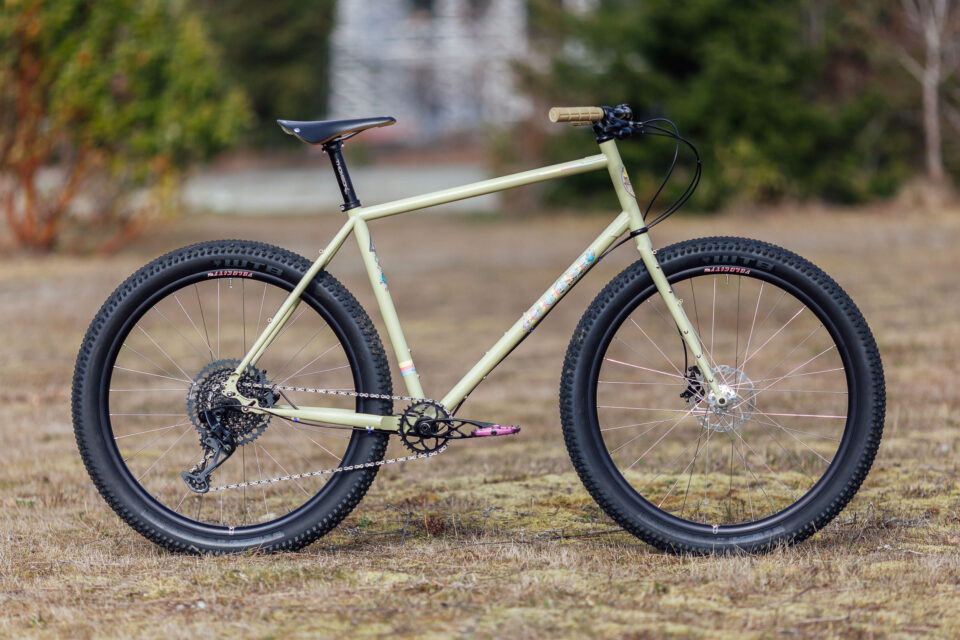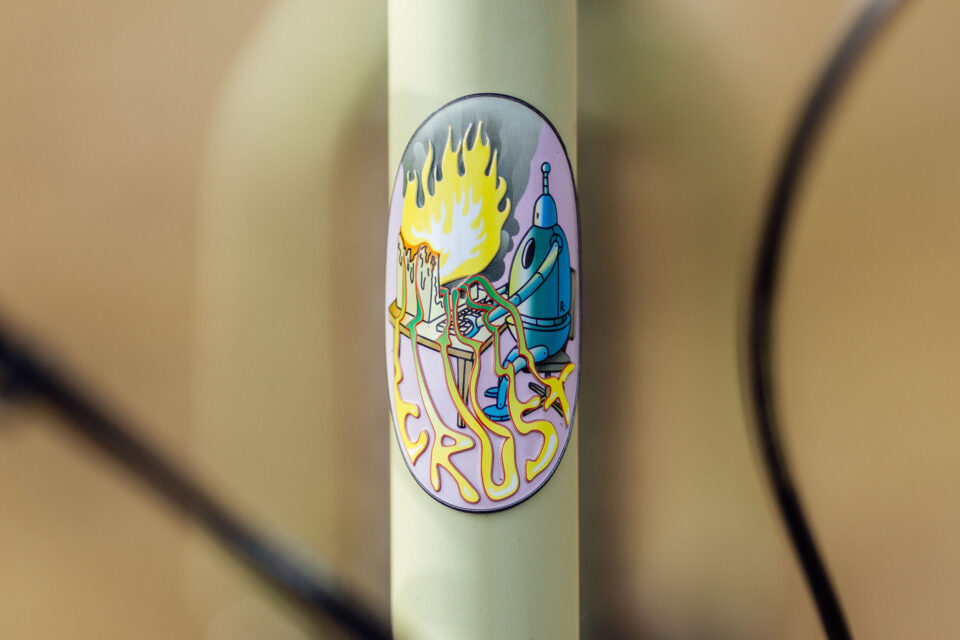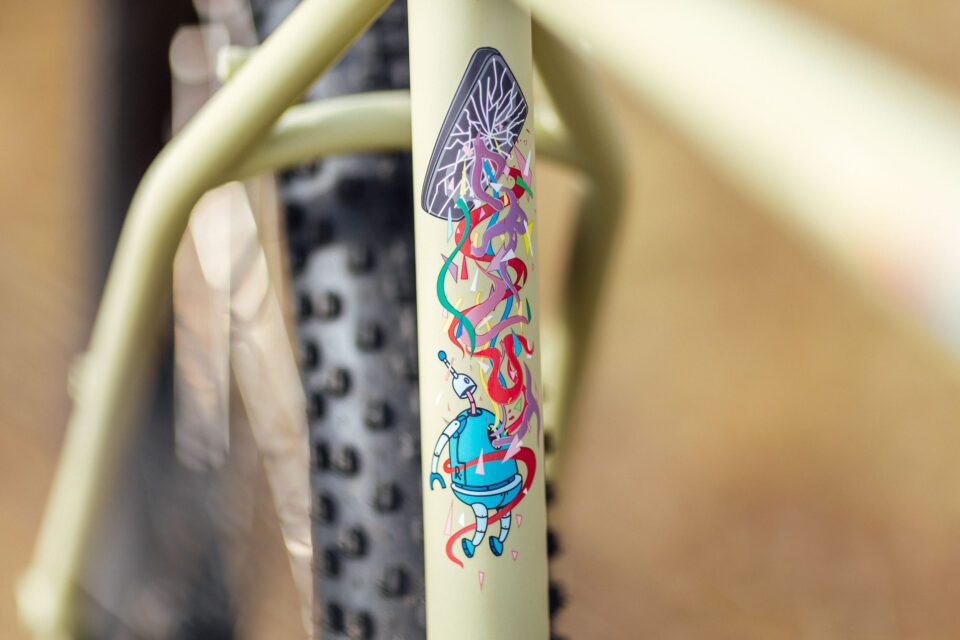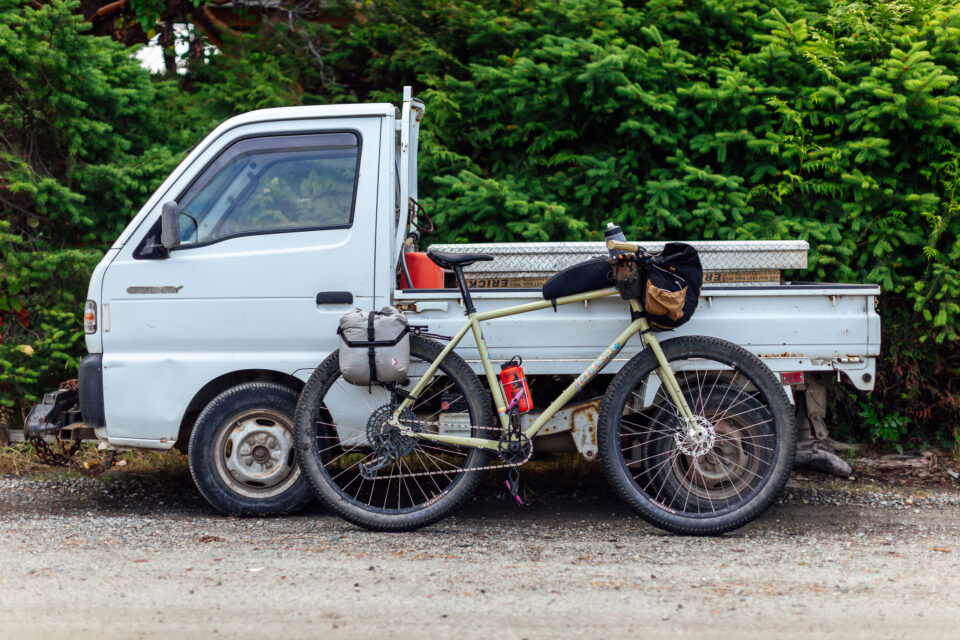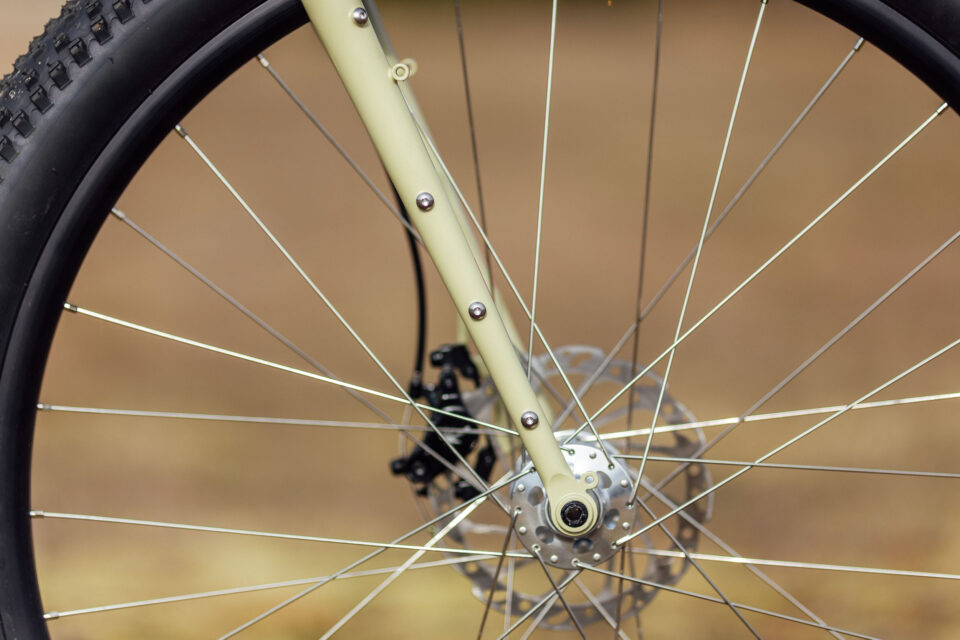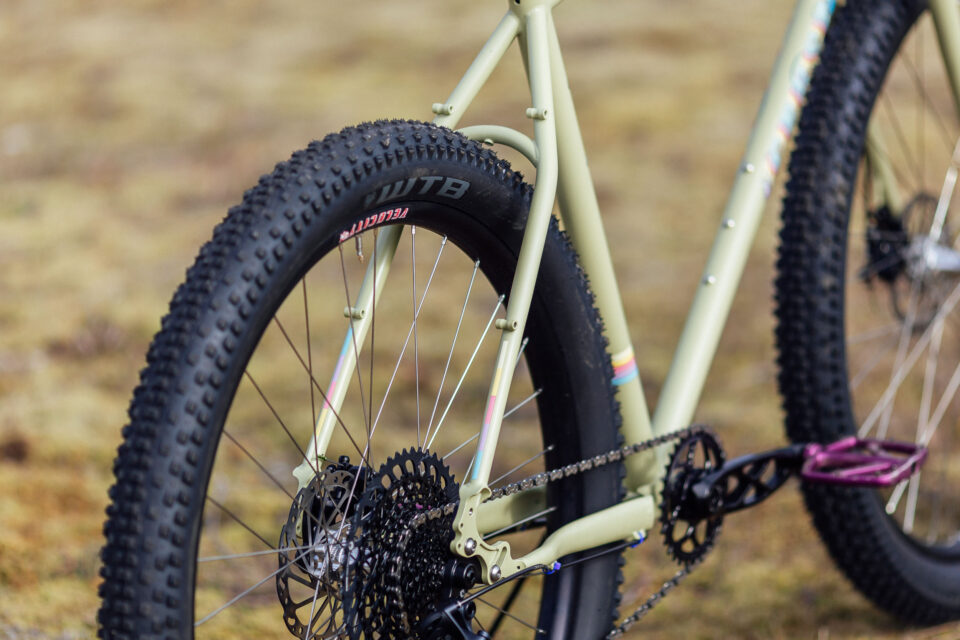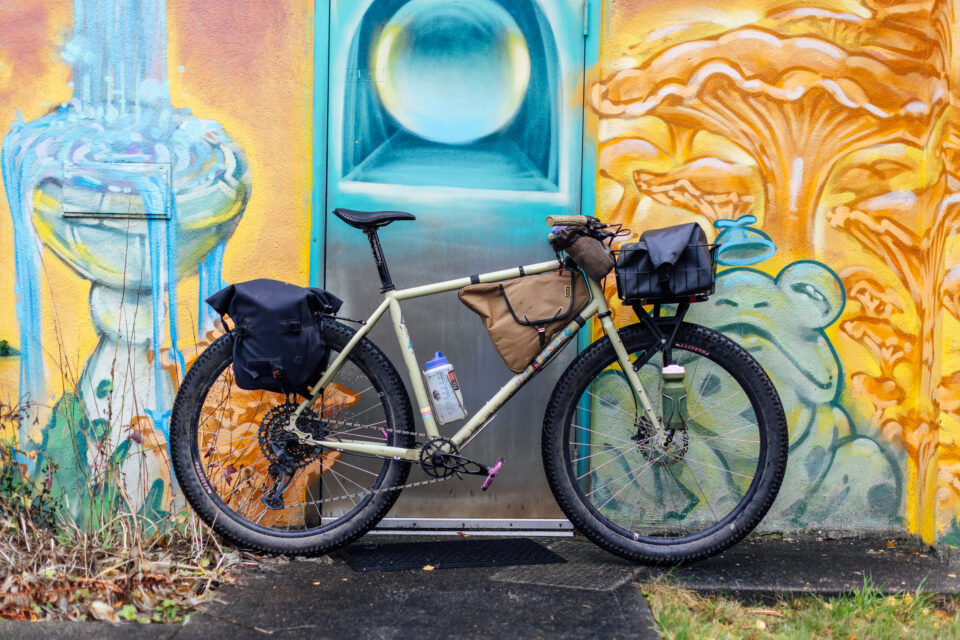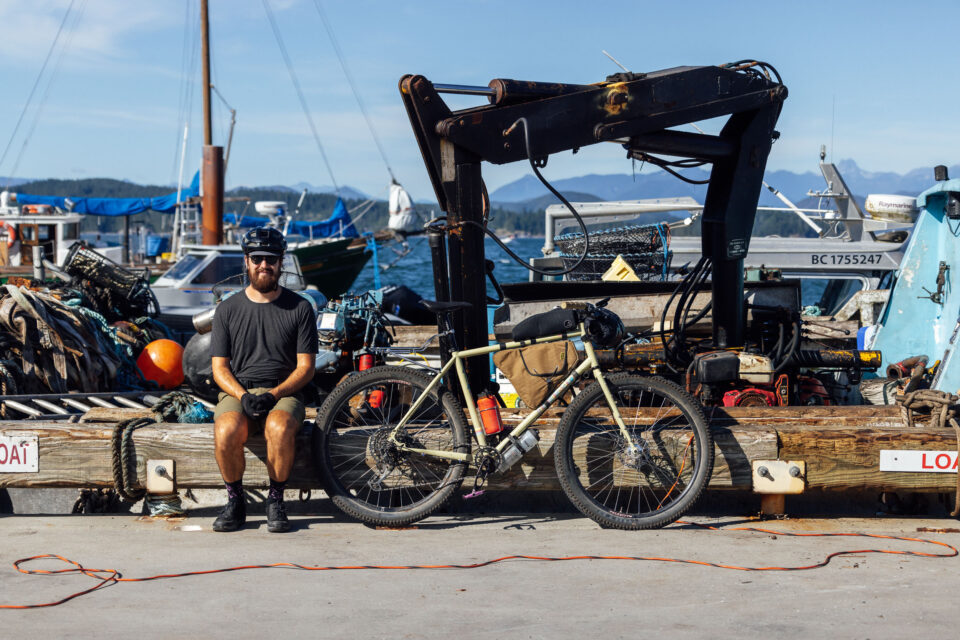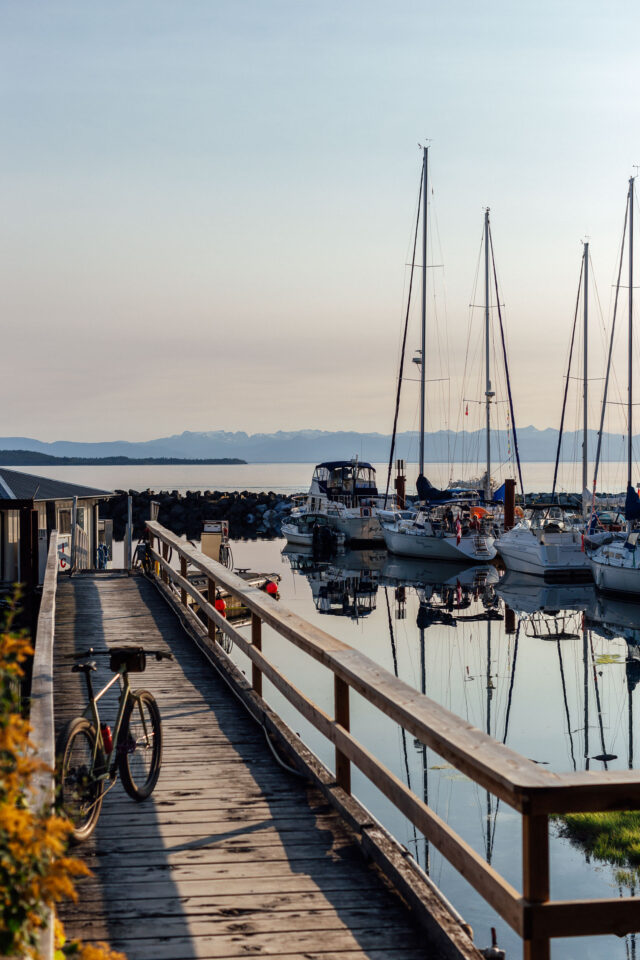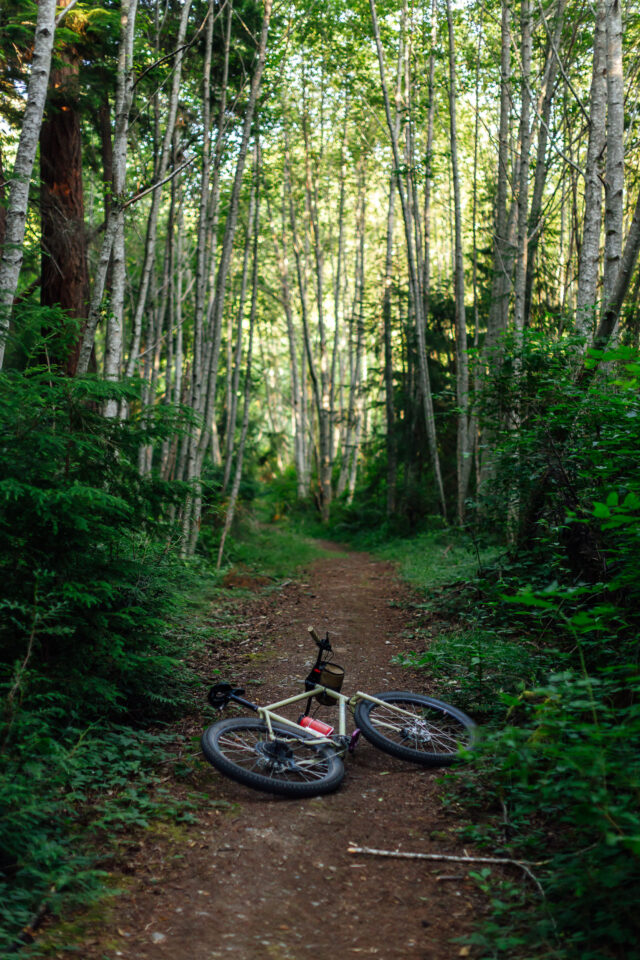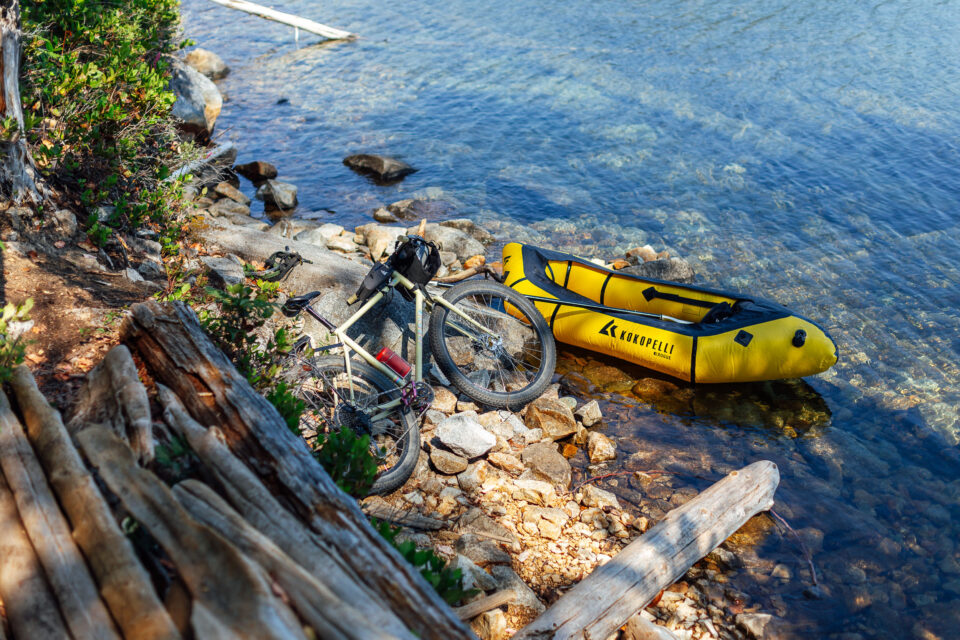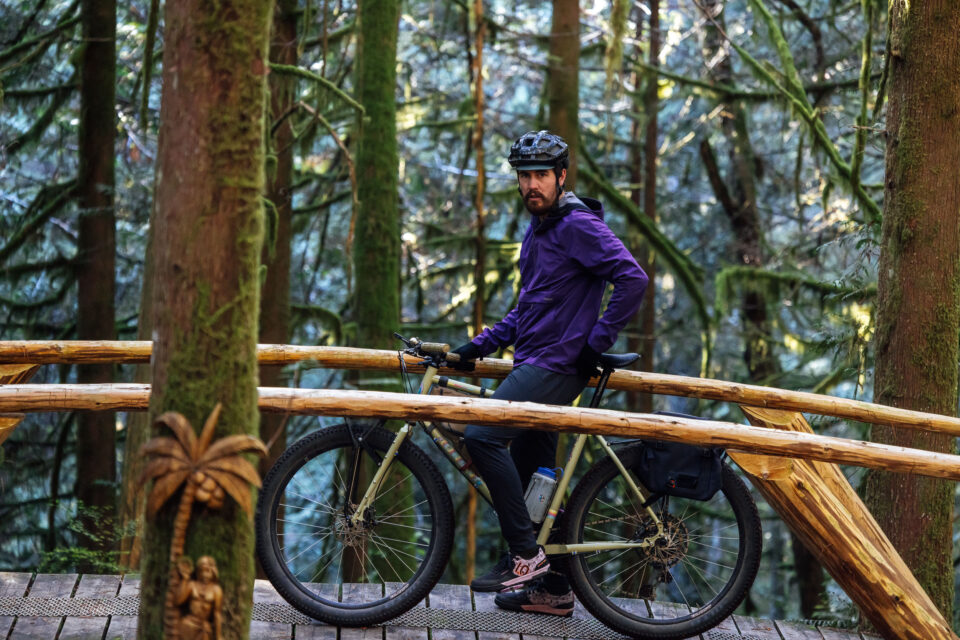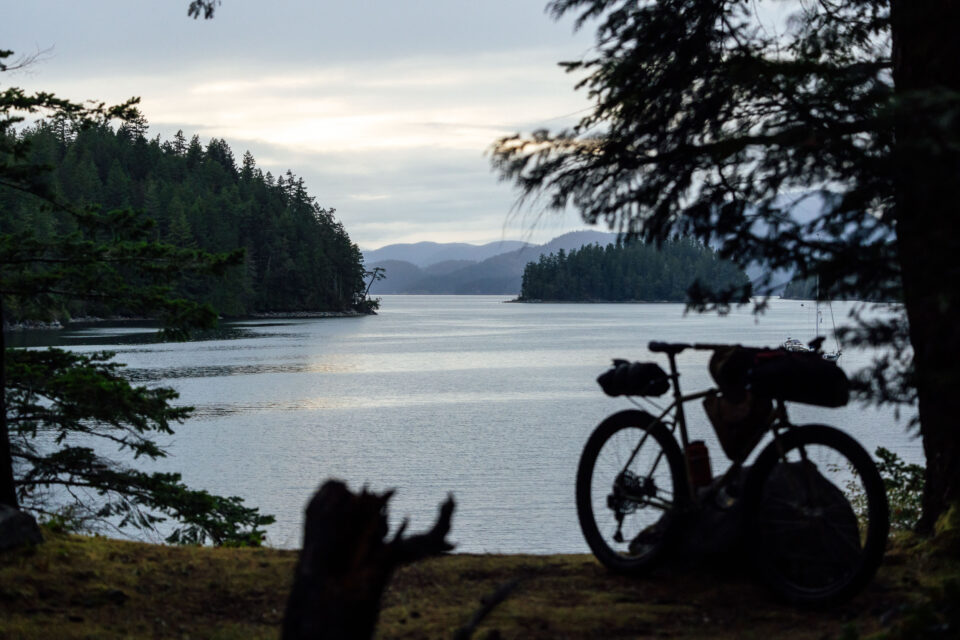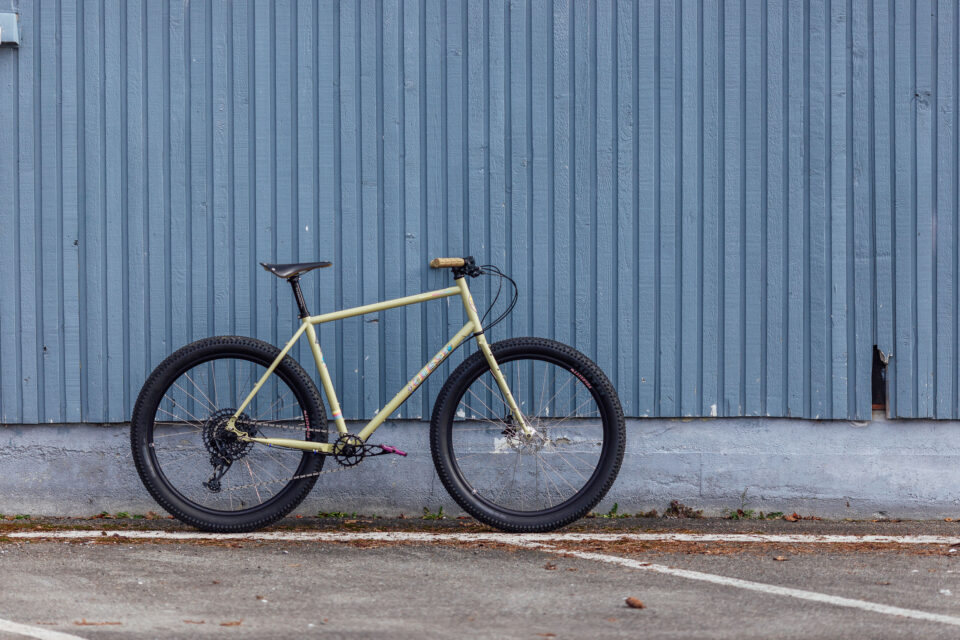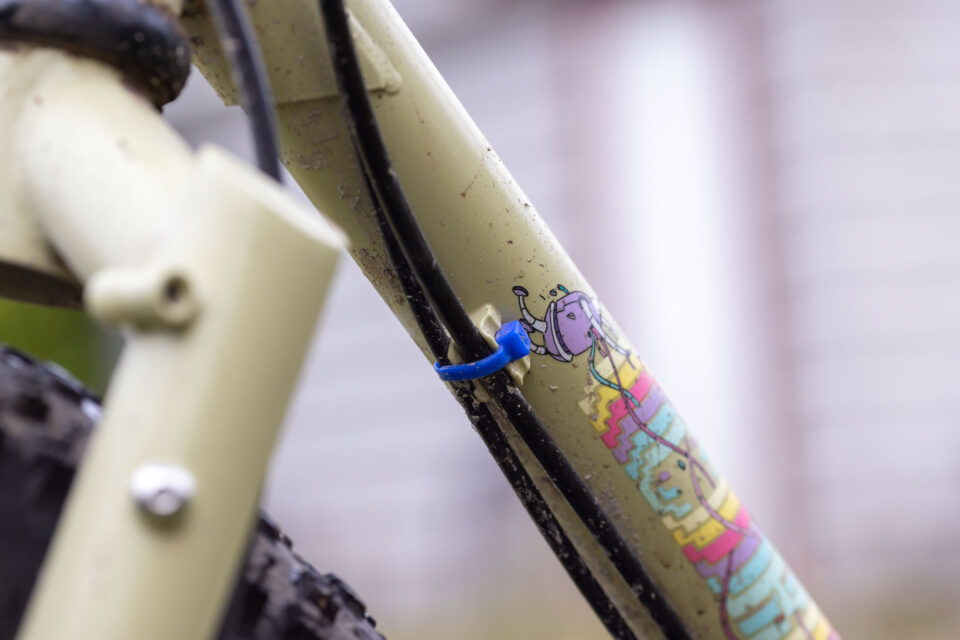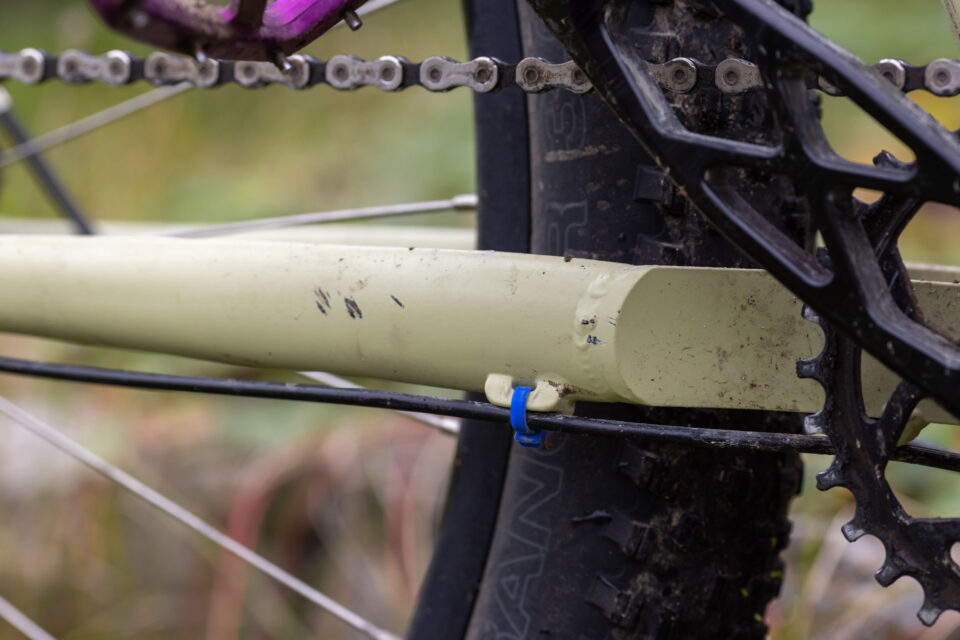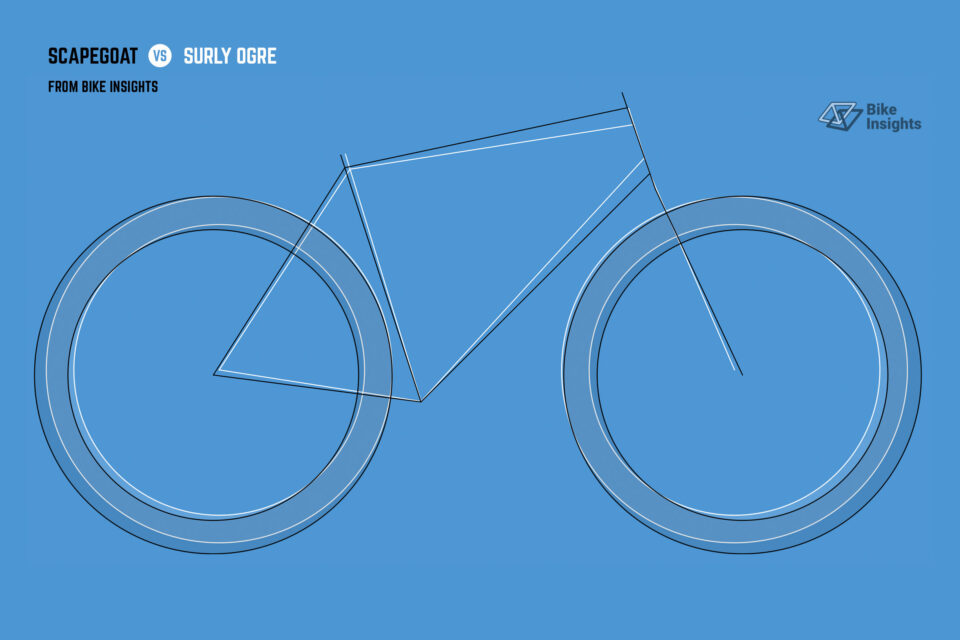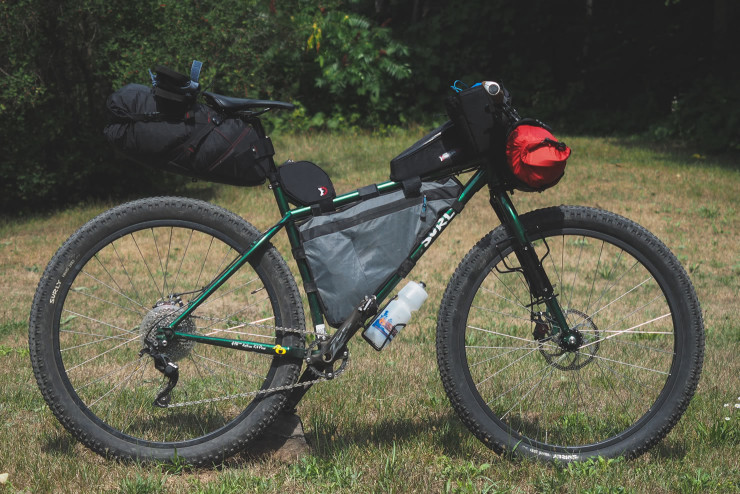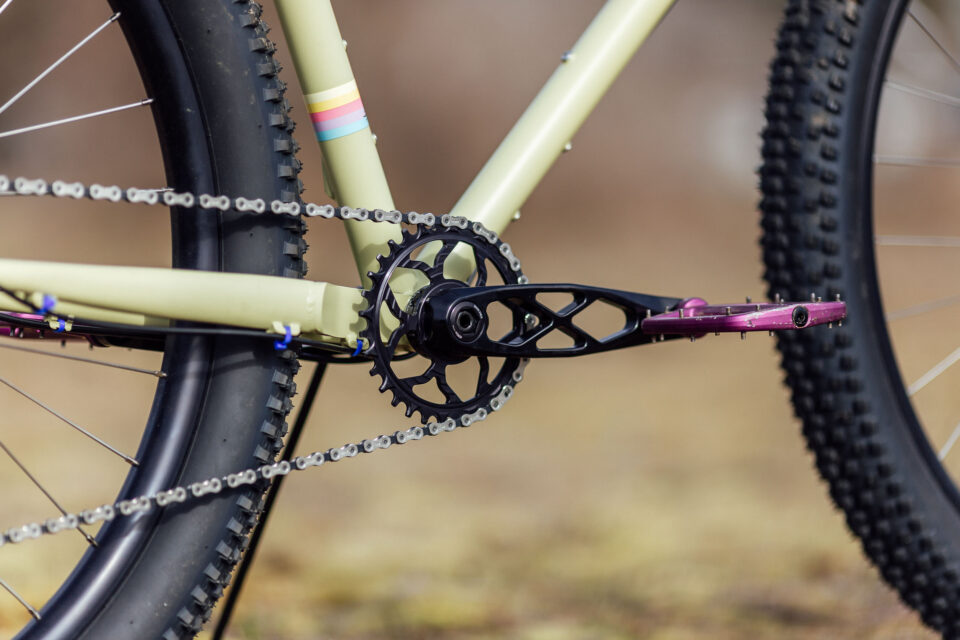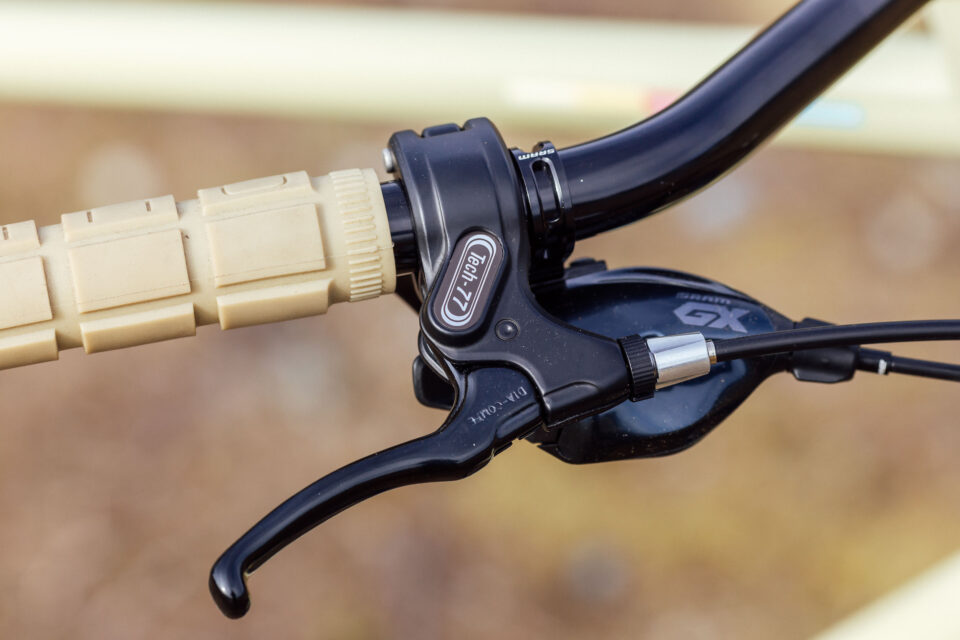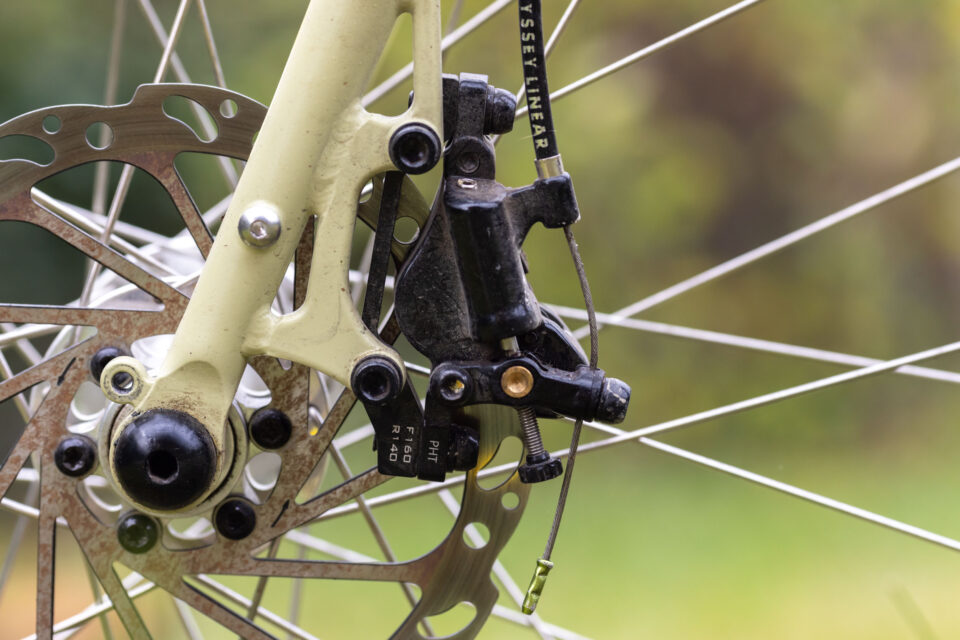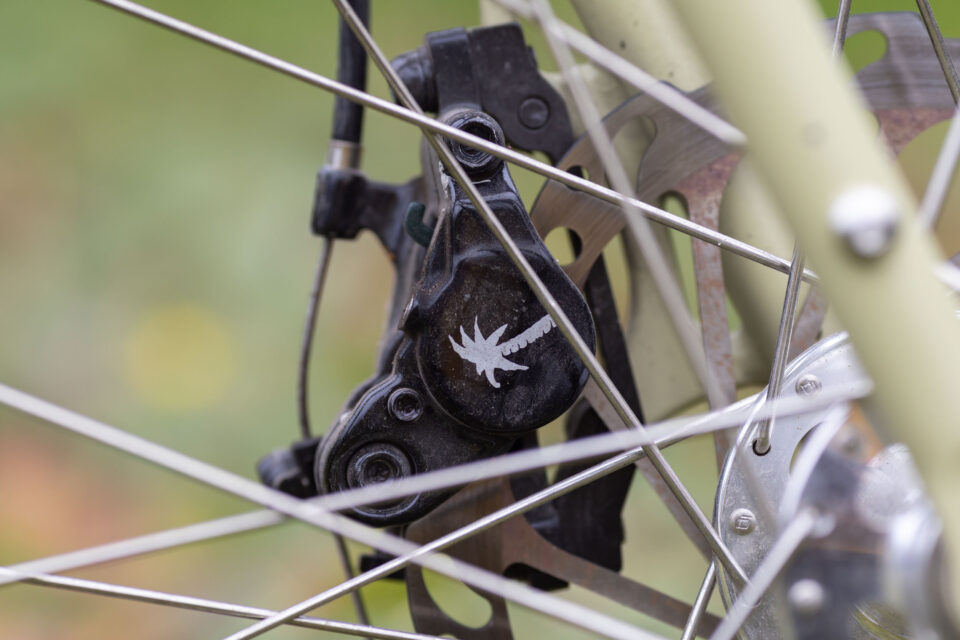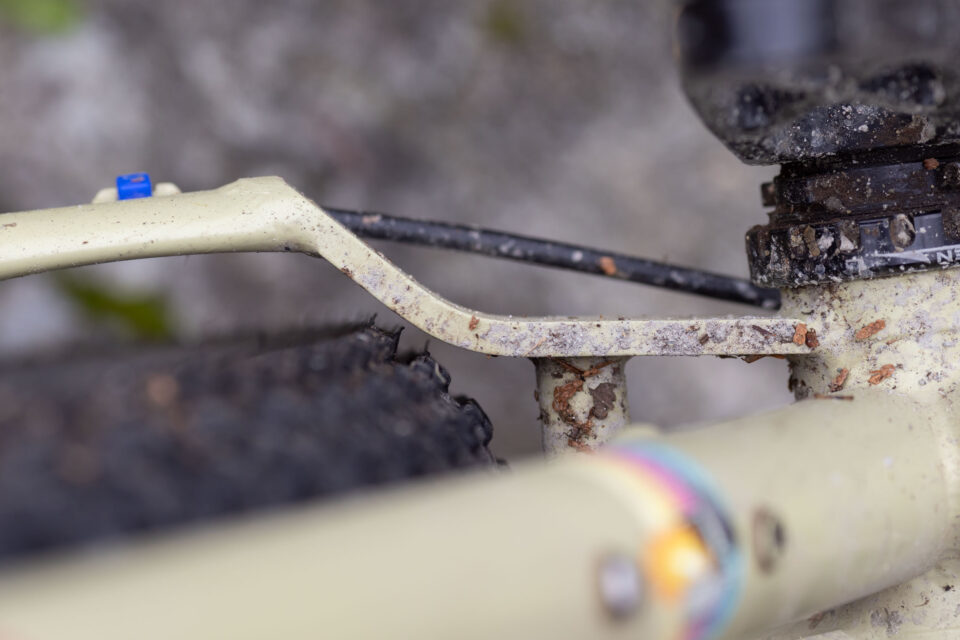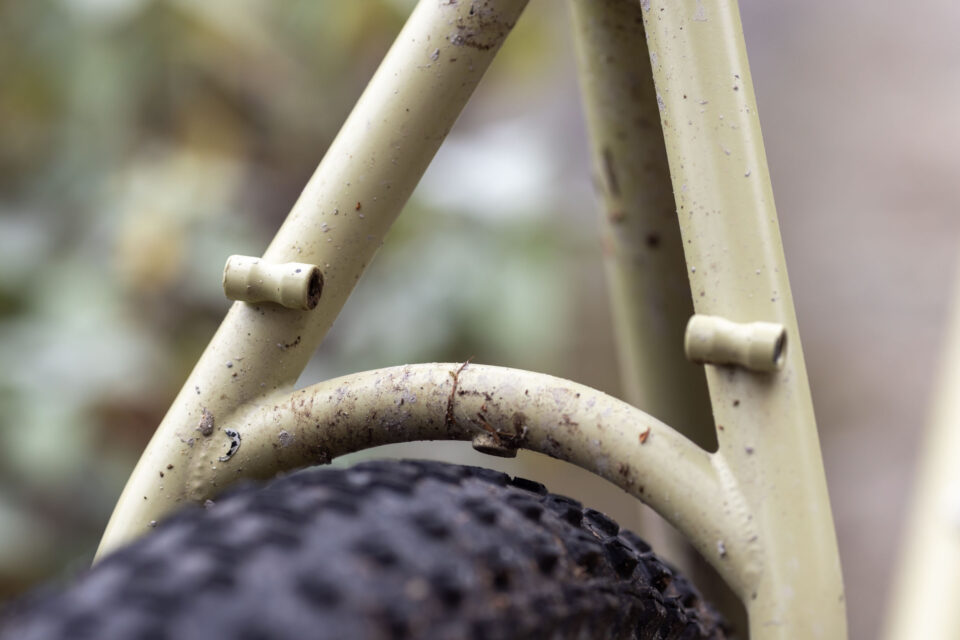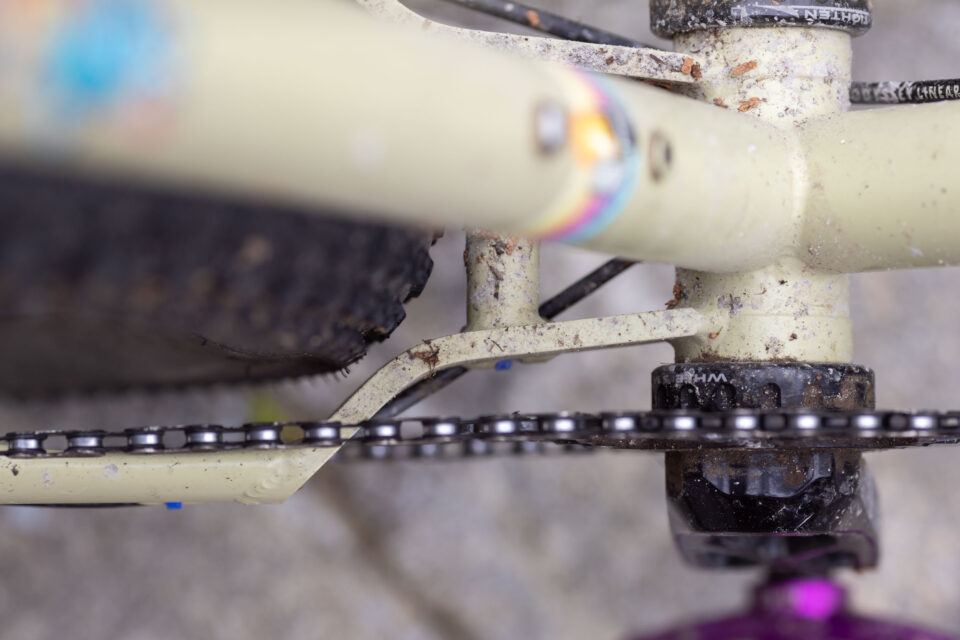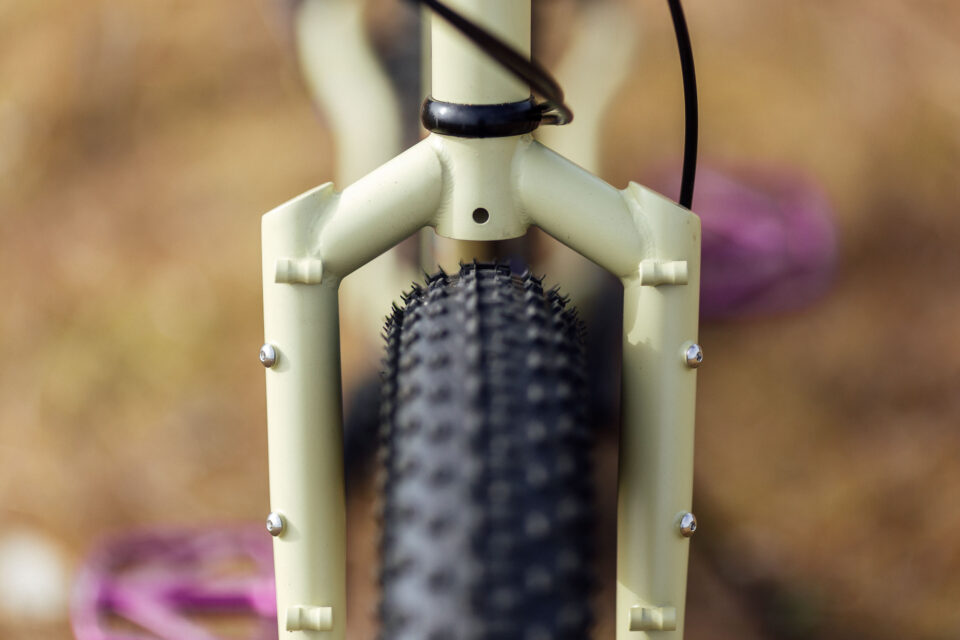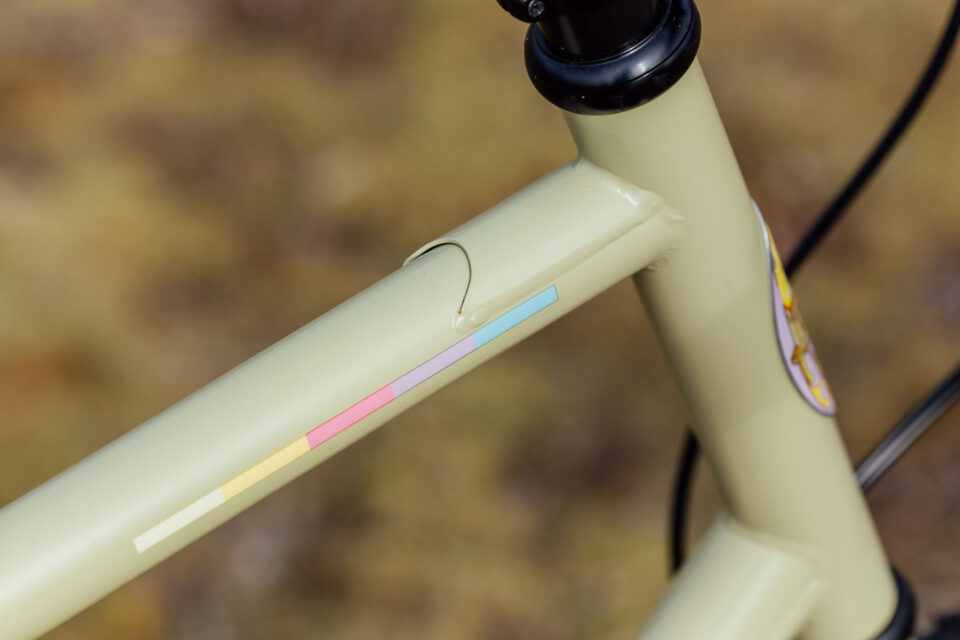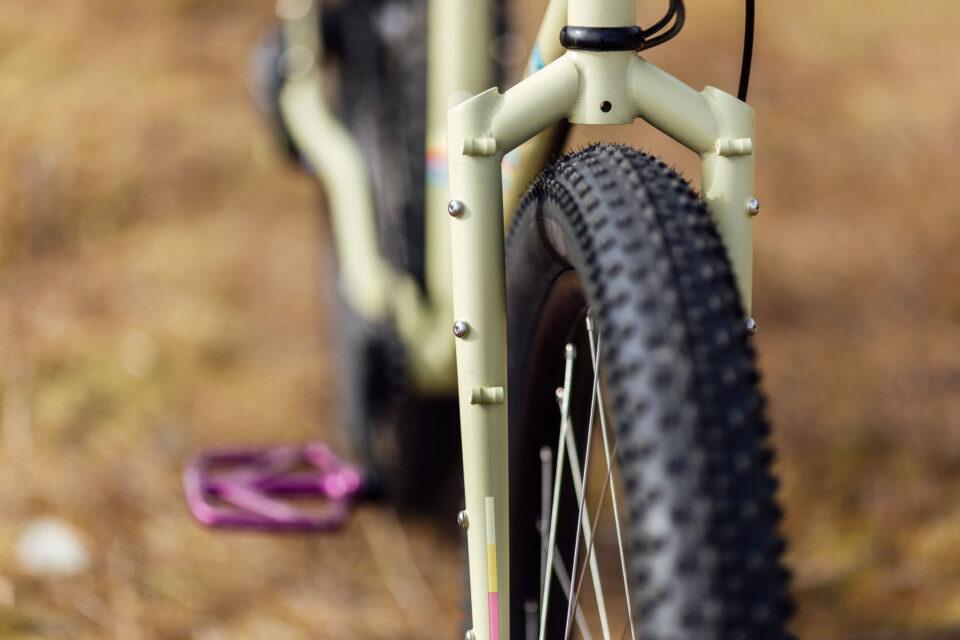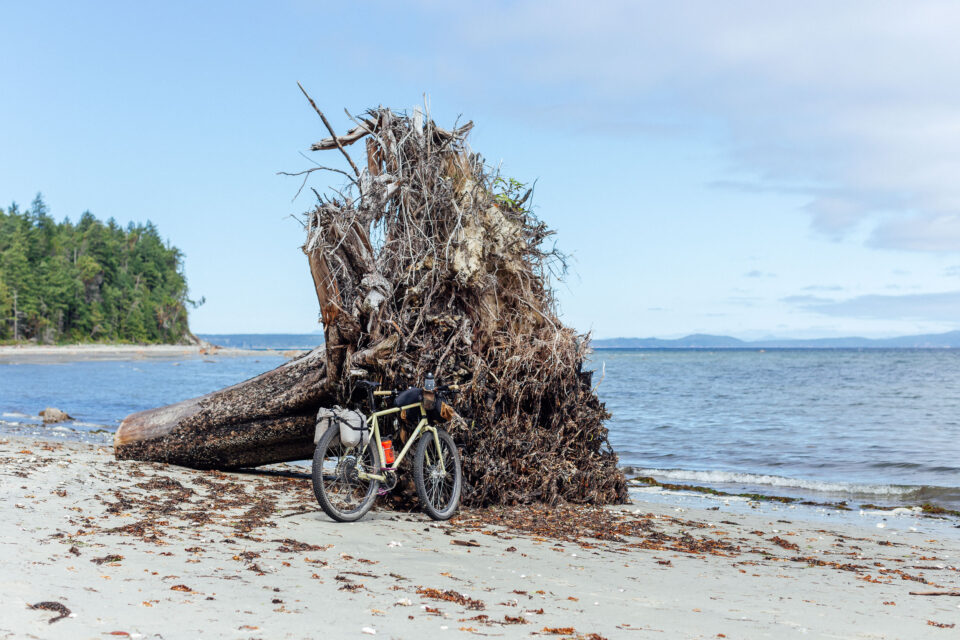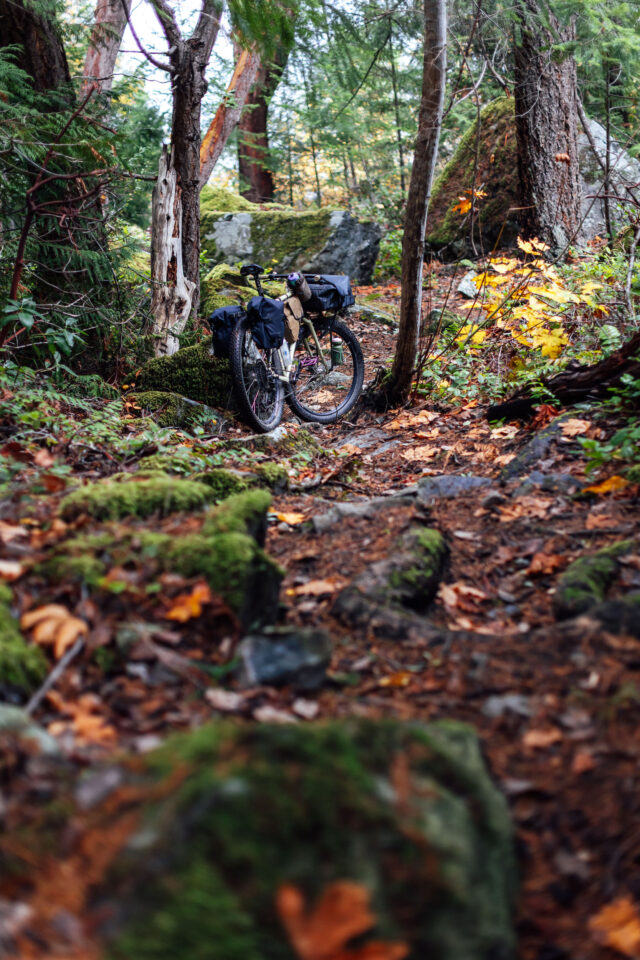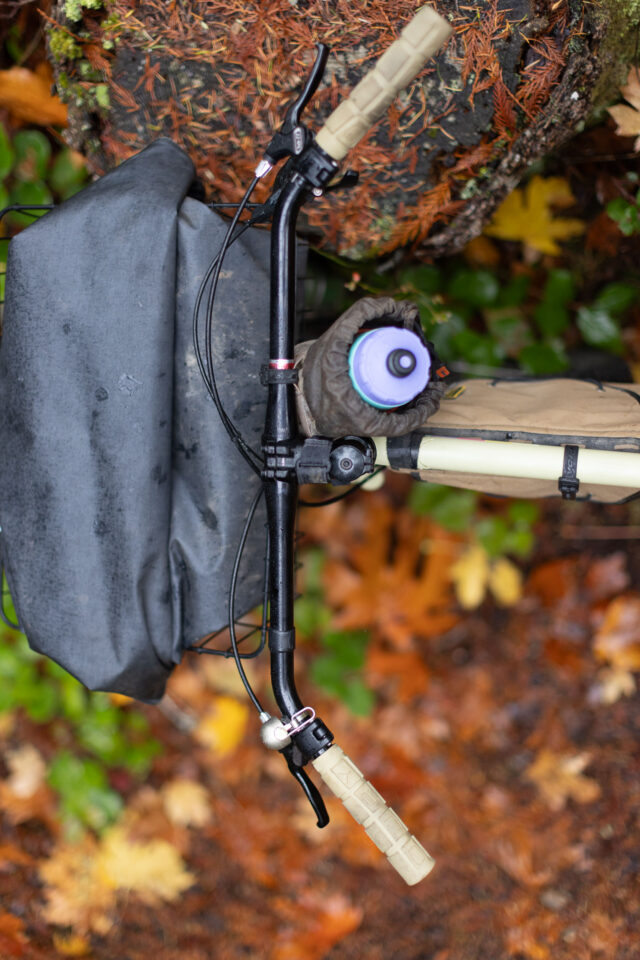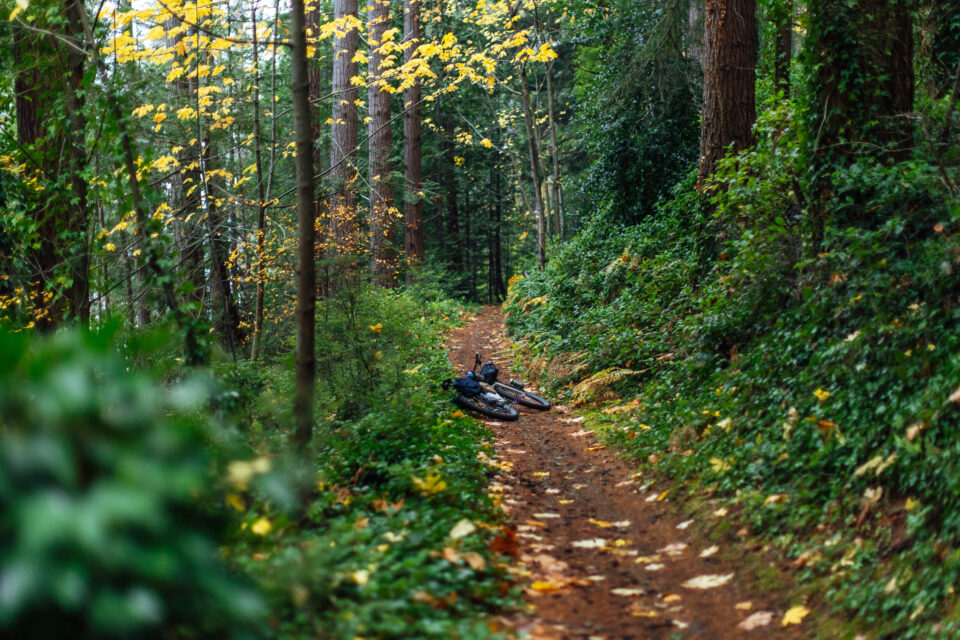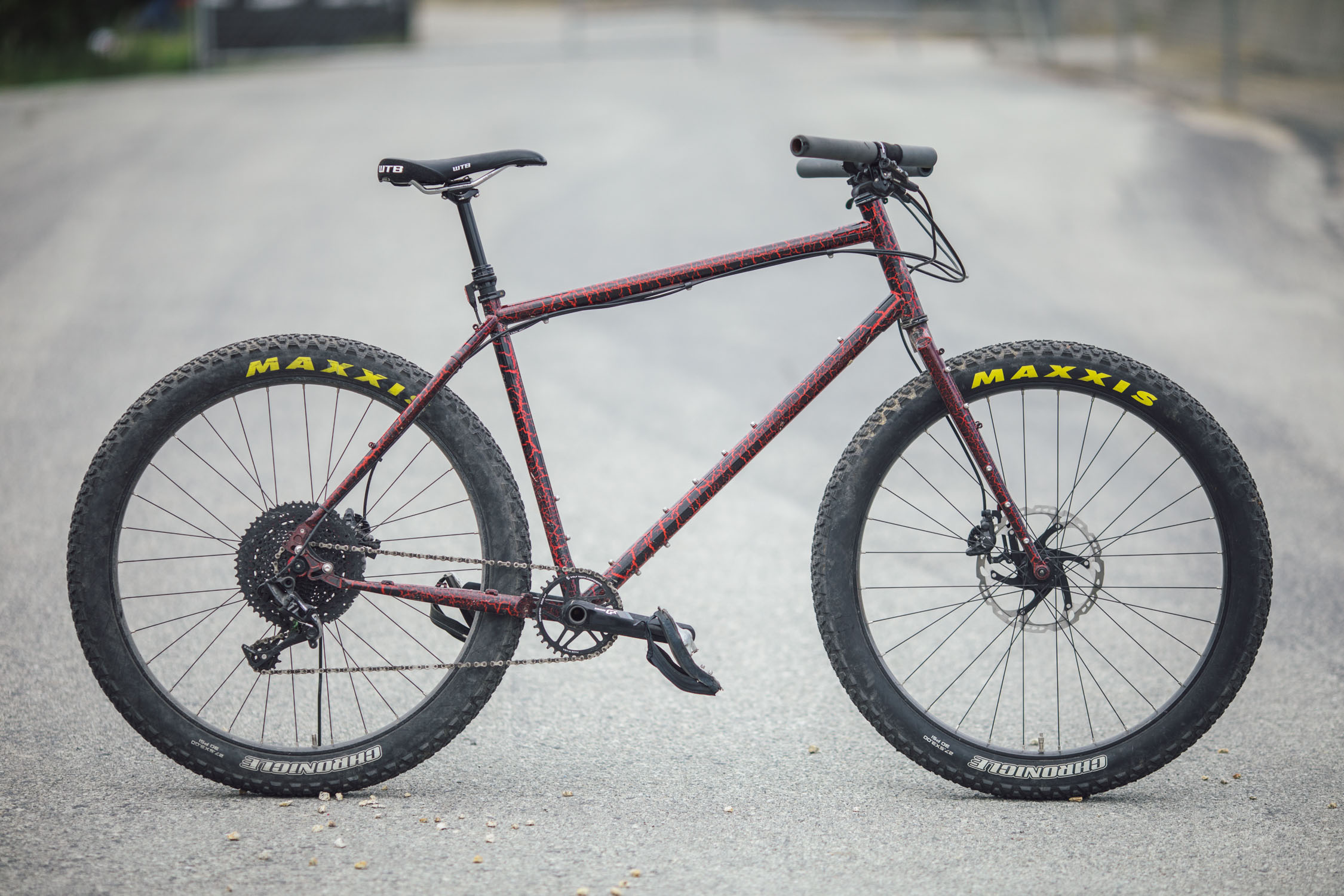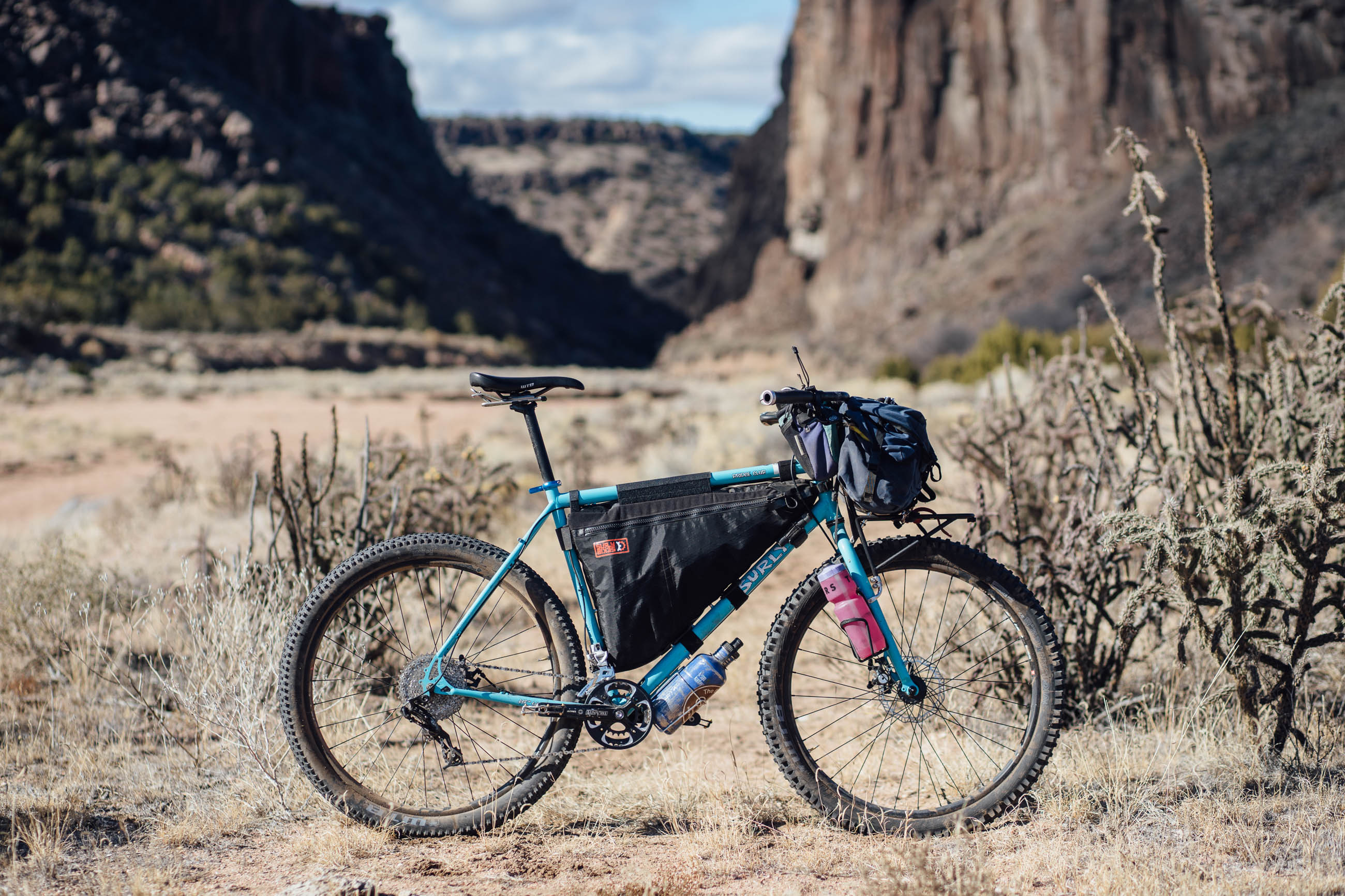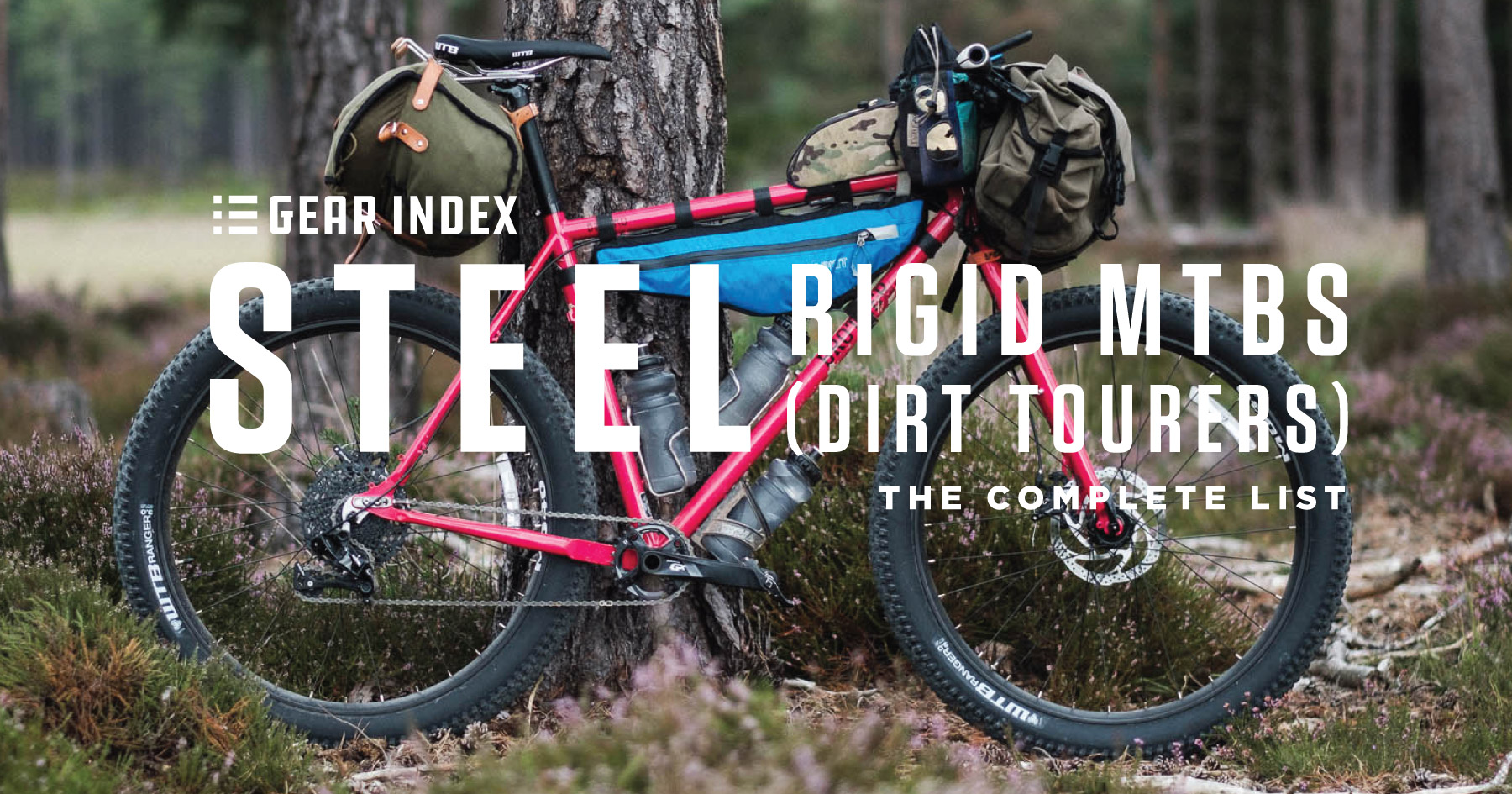Crust Scapegoat Review: ScapeBot Touring Through Time
Share This
The latest generation of the Crust Scapegoat (ScapeBot) features plenty of the specs we’d hope to see from a ride-around-the-world rigid mountain bike, including geometry tuned for heavy hauling, loads of mounting points, and clearance for 29 x 3.0” tires. After nearly a year of dirt-road rambling, packrafting, and bikepacking, find our long-term Crust Scapegoat review here…
Close to two decades ago, three friends set off on a monumental 20,000-mile bike trip from Alaska to Argentina. Their trip, known as Riding The Spine, helped shape bikepacking and big-tire dirt touring in the Americas as we know them today. Their blog inspired people all over the world, and while it was a little before my time, my colleagues Cass, Joe, Lucas, and Logan are among those who closely followed their journey. To many, they are considered trailblazers in the realm of fat-tire dirt touring and bikepacking. They expanded people’s perception of what was possible on a bike, documenting their experience in such a raw style. Goat (yes, that’s his name) was their unofficial ringleader and would later use this trip as inspiration to help conceive the Crust Scapegoat—which recently evolved into the Scapebot.
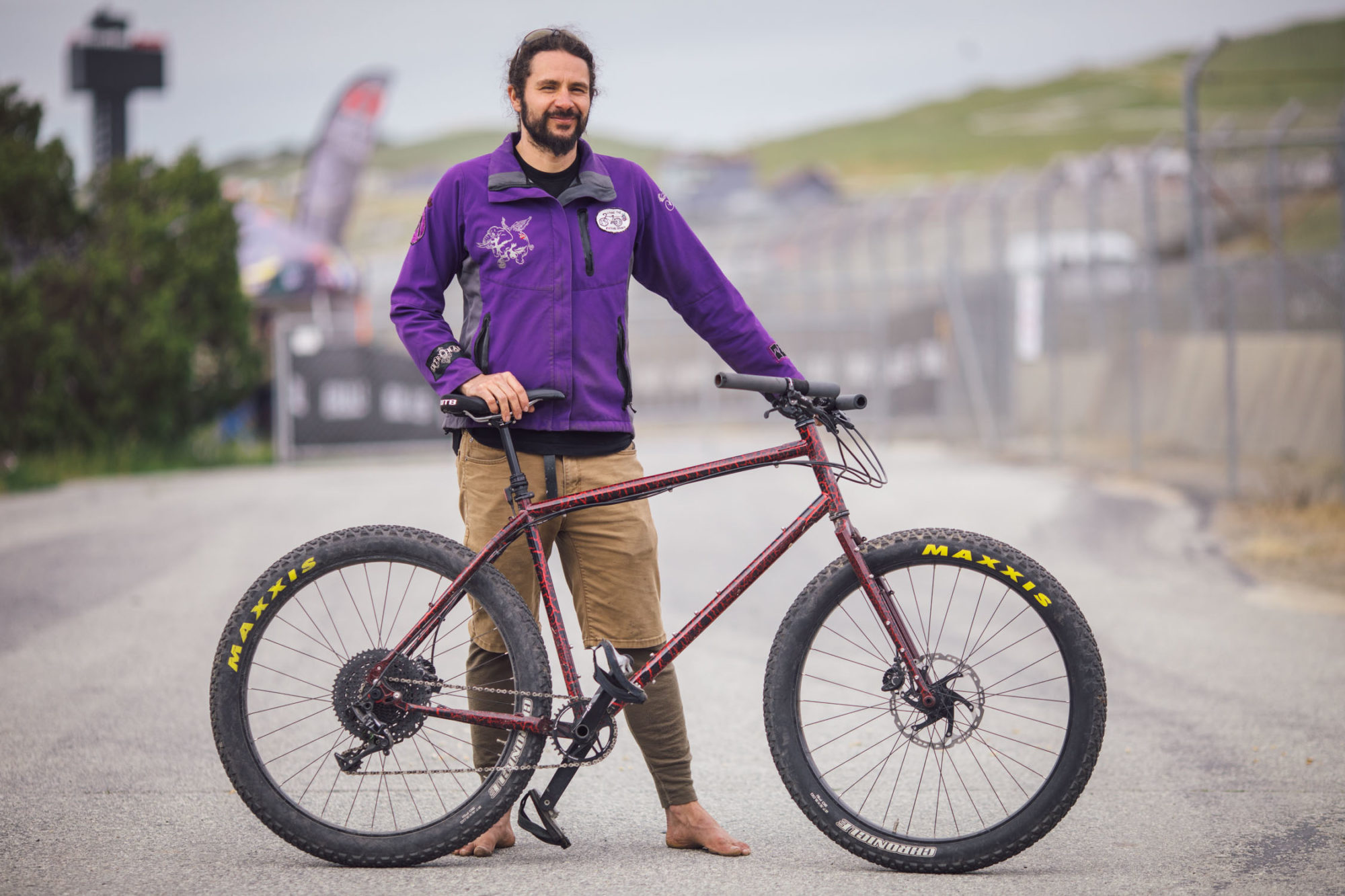
Around the same time that Riding The Spine kicked off, there was only one production fat bike available, the Surly Pugsley, and it would be another eight years before 3.0” tires and the first production 29+ bike, the Krampus, arrived, followed closely by the ECR–one of the original dirt-touring plus bikes. The Riding The Spine crew started their trip with normal-size tire mountain bikes, but while struggling with snow in the Rockies, Goat learned about Jacob Postrzygacz riding the Canning Stock Route in Australia on a first-generation Surly Pugsley with a prototype Extrawheel trailer, and he was sold on the idea of touring on a fat bike. Sean, another member of the trio, destroyed his DEAN titanium frame a year into their journey, and around that time, Surly offered up their Big Dummy to the group.
All of this clearly had some influence on Goat, as he ended up working with Traffic Cycles to build a one-of-a-kind long-tail fat bike he called the Chupacabra. It borrowed Surly’s solution to run massive fat bike tires by using an offset rear wheel. By the end of their 3.5-year trip, everyone in the group was on some sort of wacky fat-tire bike. When I asked Cass Gilbert about his impressions back then, he remembers being in awe of the Chupacabra and seeing their bikes change during the trip, Cass explained, “made it an especially memorable journey to follow, for me at least!”
For Joe Cruz, Riding The Spine served as major inspiration when he set out to ride the length of South America on a fat bike in 2011, and Goat’s long-tail was a “reassuring proof of concept,” as Joe puts it. Some digging will show that this style of riding wasn’t totally revolutionary. A standout example is Jean Naud, a Frenchman who traveled 3,200 kilometers across the Sahara from Algiers to Timbuktu on a custom long-tail fat bike in the late 1980s. Design-savvy cyclists have been figuring out the best way to travel in challenging terrain for decades, and while modern options might not be as far-reaching as these early concepts, they share a similar sense of wonder and innovation. It’s hard not to be inspired by these early documentations of what we now call bikepacking. One can’t help but get lost in thoughts of what’s possible by bike.
Seven Years of Scapegoat
Earning its namesake from Goat, the Scapegoat was prototyped in 2015 and debuted for sale in 2016. It came to be as the result of riding the Chupacabra for tens of thousands of miles and Goat realizing he wanted a bike that fit his beloved Surly Endomorph fat bike tires with a normal 73mm bottom bracket shell and a non-offset 135mm rear end.
Although it has seen some updates over the years, the overall design has remained relatively true to its origins. Just like the original, the current Scapegoat is compatible with a wide range of wheel/tire sizes, including 26” fat bike tires, 26+, 27.5+, 29+, and everything in between. It has always featured a burly steel frame, matching segmented steel fork, and a healthy assortment of mounting points. It received a first major update in 2019 with the addition of boost hub spacing and thru-axles, mountain bike-inspired geometry, and promises for more stable loaded riding.
The latest iteration of the Scapegoat was released last year with the moniker ScapeBot, featuring robo-inspired graphics and completely overhauled geometry. Geo changes included a steeper head tube angle for easier front-loaded steering, slightly shorter stack and reach, a longer seat tube for a larger main triangle, a longer rear end to accommodate 29 x 3.0″ tires, and a higher bottom bracket. It’s still based around a Taiwan-made Chromoly steel frame, loads of rack and bottle bosses, and room for plus-sized tires.
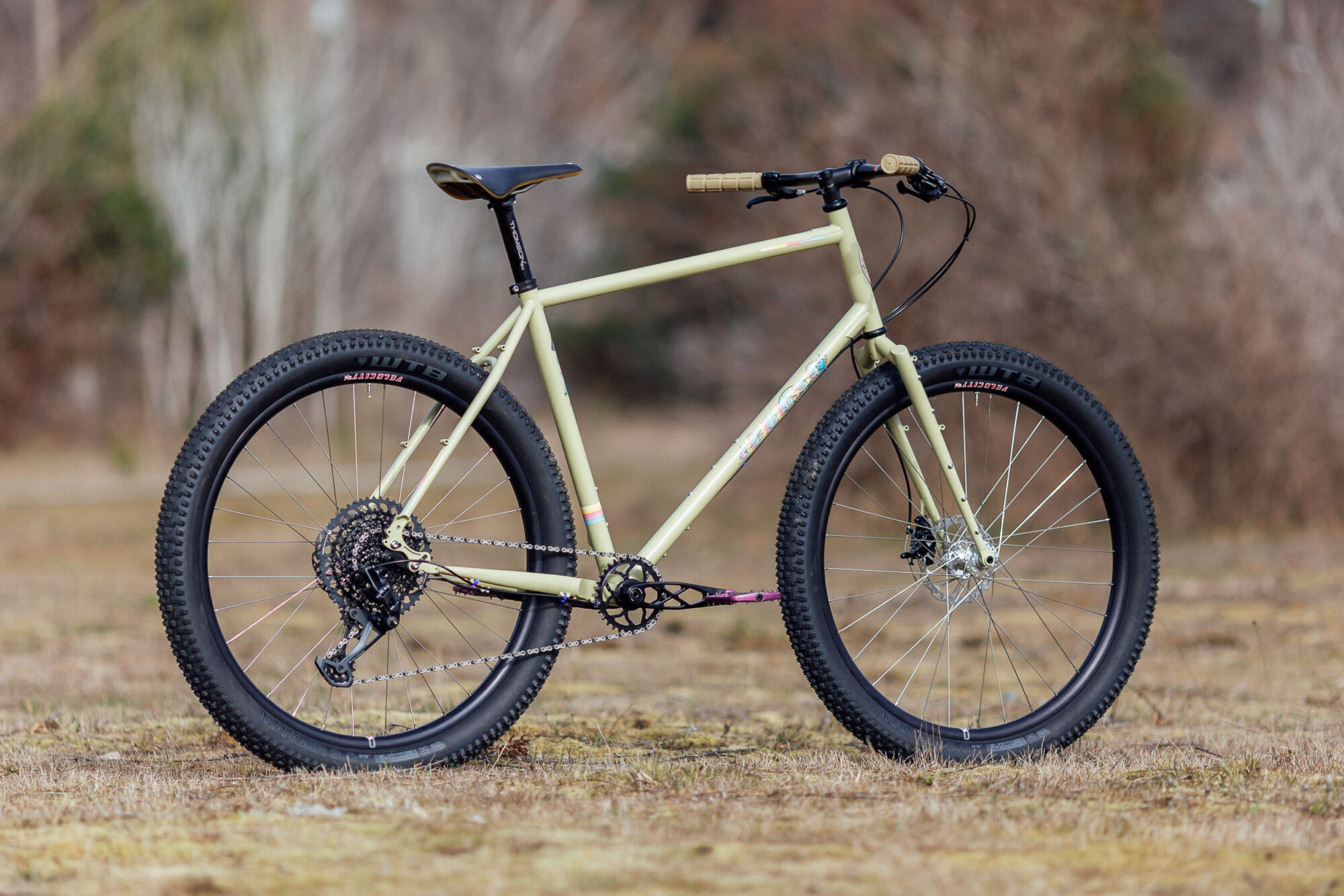
Just like the Scapegoat’s ride-around-the-world design philosophy, the ScapeBot has a unique look that’s worth dissecting. First, the paint job of the model I tested exactly matches the Pantone of old Macintosh computers. It’s also available in purple with a pink fade fork for those seeking something brighter. I reached out to Nick Kuszyk, the artist behind the ScapeBot’s graphics, and voiced that the burning of outdated computers and spirits enrapturing broken cell phones speaks for itself in terms of sentiment. Nick explained it’s primarily a “fuck this shit, let’s ride bikes!” message.
Even the natural beige color of the version I tested doesn’t take itself too seriously with the addition of rainbows and other colors in the graphic. The purple frame with faded pink fork, on the other hand, is “unapologetically in its extreme hotness,” said Nick. Perhaps the funniest insight Nick mentioned was that Crust Founder Matt Whitehead was hesitant to offer the beige frame at first because “boring colors always sell too well.” Nick was also pushing for some of the geometry changes that were put into place on the current Scapegoat, which I’ll dig into later.
The Scapegoat ScapeBot: Specs and Details
The latest Scapegoat “ScapeBot” was overhauled in 2022 without losing any of its original overlanding DNA. It’s built around a foolproof double-butted 4130 Chromoly steel frame and a matching non-suspension-corrected segmented fork. The frame has a whopping 12 threaded bosses for cages, racks, bags, and more. If that’s not enough, the fork has a staggering 16 bosses plus a fork crown hole for racks and fenders. Based purely on how many mounting points there are up front, if you were to guess that it’s specifically tailored for a heavy front load, you’d be right.
- Highlights (XL)
- Frame: 4130 Chromoly Steel
- Angles (XM): 71° Headtube, 72° Seattube
- Stack/Reach: 667mm/433mm
- BB Drop/Chainstay: 58mm/451mm
- Bottom Bracket: Threaded (73 mm)
- Hub specs: 15x110mm / 12x148mm, TA
- Seatpost: 31.6mm
- Max tire size: 29 x 3.0″
- Price: $1,175 USD (frame and fork)
The Scapegoat uses a Paragon rocker-style rear dropout, allowing for single-speed and Rohloff internally geared hub setups. The dropout also provides 0.68” (17mm) of sliding adjustment and 0.03” (0.75mm) of vertical adjustment, thanks to an arched bolt position. The benefit of using this style of dropout for a bikepacking bike is that the rear brake caliper is tucked inside the frame, leaving plenty of room for racks, fenders, and threaded eyelets. There is no seatstay split for belt drives, but you could get around that by using a split belt. It relies on boost hub spacing and thru-axles front and rear, front I.S. brake mount with a post mount adapter, rear post mount, and there are a few different brake/rotor options available, depending on your needs. The size small was previously 26+ specific, but the latest changes resolve the earlier tire/frame/fork clearance issues and put it in line with the other sizes, although Crust suggests 26+ setups work best on the size small to avoid toe overlap.

As far as modern, fully rigid mountain bikes go, the Scapegoat checks most (if not all) of the boxes we like to see. The frame has a 73mm threaded bottom bracket, a regular Q-factor (distance between the cranks), huge tire clearance, a modern 31.6mm seatpost diameter, a standard 1 ⅛” headtube, and a conversation-inducing paint job. But is it a mountain bike or something else?

Long Story Short
A couple of the Scapegoat’s more significant geometry changes came in the form of a shorter front end and longer seat tube. The reach decreased by around 25mm across the entire size range, the effective top tube shortened by about 30mm, and the seat tube length grew by about 40mm. These are significant changes—enough that the size medium 2019 Scapegoat now looks more like the size large 2022 Scapegoat. But why?
In part, we have Nick Kuszyk to thank for this. Being good friends with the Crust team and already being so involved with the graphics, Nick pushed for the changes we see on the current Scapegoat. The shorter reach, 29+ tire clearance, and steeper head tube angle are all changes Nick recommended, and Crust listened. Nick wanted it to feel like a “mountain travel tank” and to be better suited for heavy front loads. The steeper head tube angle brings whatever load is weighted over the front tire closer toward the rider and offers a more stable ride compared to having a heavy load on a bike with a slack head tube angle with the weight way out front. It’s the reason why low-rider panniers on traditional road touring bikes make so much sense.

But wait, isn’t the Scapegoat a mountain bike? In the beginning, it leaned in that direction, but today, it’s something else. The shorter reach actually puts it further toward the drop-bar monstercross category than most 29+ rigid mountain bikes. The Tumbleweed Stargazer was one of the first comparable bikes I could find when considering frame geometry and sizing. The Salsa Fargo isn’t far behind either, but it has a significantly higher stack height. Same story with the Panorama Taiga EXP.
Proper 29+ mountain bikes that you’d expect to compare against the Scapegoat aren’t as similar as you might expect. Popular options like the Surly Krampus, Kona Unit, Tumbleweed Prospector, and Bombtrack Beyond+ are significantly longer and more slack, shifting the rider’s weight forward and being better suited to steep, technical terrain. Although they aren’t 29+ compatible, the Surly Bridge Club and Surly Ogre are the closest in terms of geometry, but they’re still slightly longer and not quite as tall in the front. Mind you, they both come in at about half the cost of the Crust.
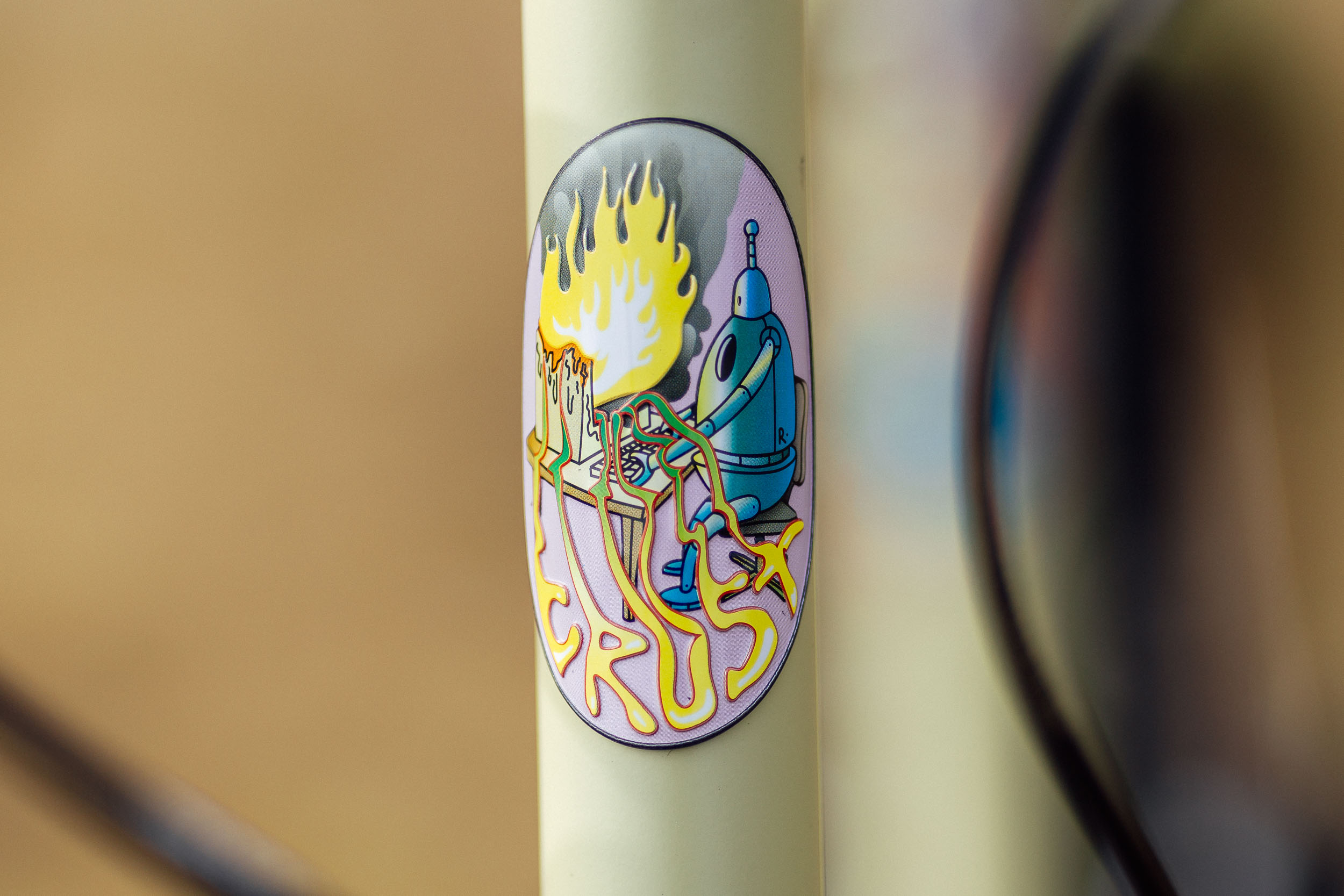
The Scapegoat’s short reach and slack seat tube shift the weight out of your hands and into your feet, providing an incredibly comfortable and upright riding position that’s great for anyone who likes to keep their head up, check out their surroundings, and wave at speedy spandex-clad cyclists chasing FKTs. While the 29+ bikes mentioned above have slacker front ends and more tire out on front for steep descents, the Scapegoat’s long chainstays keep the overall wheelbase long and stable.
Perhaps the most comparable bike is the Jones SWB, which sports a similar wheelbase, chainstay length, and, of course, a short reach (a design choice that has become almost synonymous with the Jones name). Coincidentally, the last time I rode a big-tired bike with such an upright position was three years ago on Cass’ Jones Titanium SWB, and both bikes feel considerably different than the long-reach hardtails I spend most of my time on. Paired with wide, swept-back handlebars, they have all the fixings for a relaxed but super capable bikepacking rig that eats chunky dirt roads and steep climbs for breakfast. I distinctly remember the titanium Jones having a more lively ride quality, likely due in part to its lightweight frame, whereas the Crust has consistently offered one of the most grounded rides I’ve experienced.
Here’s a quick snapshot of where the Scapegoat falls in among other rigid, big-tired steel bikes. Note that the Jones SWB is not included because they don’t provide complete geometry charts, but I’d wager a guess that it would be close to the Crust. The comparison chart below shows a number of bikes comparable to the Scapegoat, including two drop-bar bikes marked with an asterisk (*). I’ve included the reach, stack, head tube angle (HTA)/seat tube angle (STA), and wheelbase (WB) for each. A quick glance will show a short reach, medium-high stack, and less bottom bracket drop (higher bottom bracket) than others in the list.
| Bike Model (size) | Reach | Stack | HTA/STA | WB | BB Drop |
|---|---|---|---|---|---|
| Crust Scapegoat (L) | 412mm | 637mm | 71°/72° | 1110mm | 58mm |
| Surly Bridge Club (L) | 434.5mm | 590mm | 71°/73° | 1093mm | 60mm |
| Surly Ogre (L) | 427.7mm | 613mm | 72°/73° | 1084.6mm | 68mm |
| Brother Cycles Big Bro (L) | 432mm | 616mm | 70.5°/73° | 1118mm | 60mm |
| Bombtrack Beyond+ (L) | 434mm | 644mm | 68.5°/72° | 1160mm | 70mm |
| Surly Krampus (L) | 448mm | 612mm | 69°/72.4° | 1138mm | 60mm |
| Tumbleweed Prospector (L) | 444mm | 640mm | 69.5°/73° | 1170mm | 58.5mm |
| *Salsa Fargo (L) | 385mm | 671mm | 69°/73° | 1127mm | 70mm |
| *Tumbleweed Stargazer (L) | 389mm | 653mm | 69°/72.5° | 1119mm | 63.5mm |
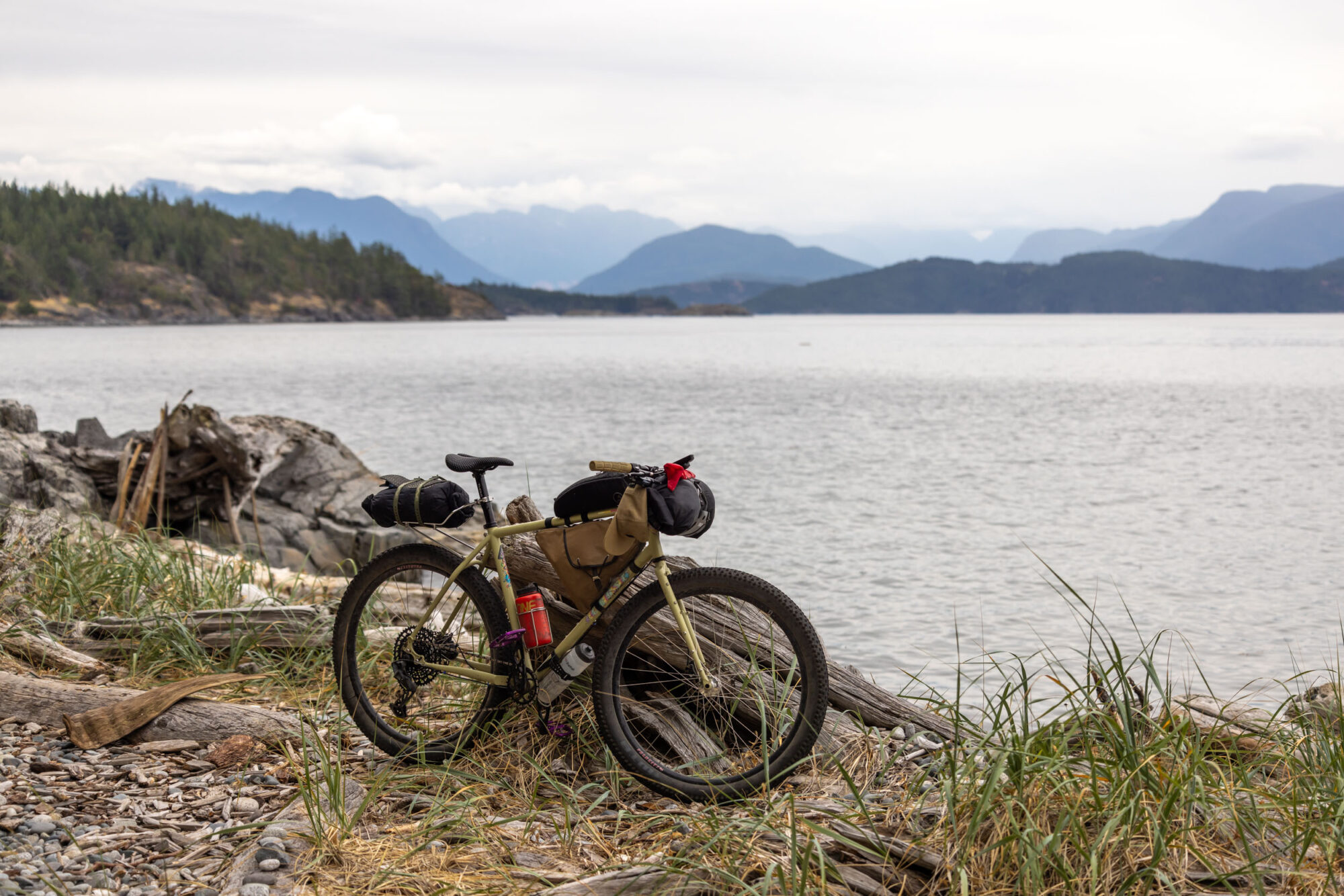
Under and Over-Biking on the ScapeBot
I received the Scapegoat right before my six-week backpacking trip in Australia earlier this year. Given Crust’s beginnings—founder Matt Whitehead is Australian—it felt right to give it a proper shakedown on a multi-week trip Down Under, but I really wanted to avoid flying with a bike halfway around the world, so I opted not to bring it. In hindsight, the Scapegoat would have been a fantastic option for that trip, which followed primarily smooth dirt roads, rough doubletrack, sand, and the occasional taste of singletrack. The Curve GMX+ I rode was fantastic, but I would have appreciated the Crust’s more upright riding position. In my eyes, that’s one of its greatest selling points.
I find flat bars provide better handling than drop bars on technical terrain, and nine times out of ten, I’d take a flat bar over a drop bar if my bike’s tires are 2.2” or wider. However, the Scapegoat’s shorter reach, swept-back bar, and steep head tube angle always found a way to steer me toward dirt roads and doubletrack rather than technical singletrack. In more ways than one, it rides like a drop-bar bike. In fact, I’d say the best way to describe how it rides is like a hybrid mountain bike with gigantic tires. I’d also like to point out that the Scapegoat has some similar angles to the original 2005 Surly Pugsley–the bike that started it all. It appears we’ve come full circle.

I felt the effect of the compact front end on steep or technical terrain. It seemed a little twitchy navigating tight corners and awkward trail features, almost like a monster truck rolling over a course that’s slightly too narrow. It was as if I was always toeing the line between appreciating the comfy upright position and wanting a longer and more aggressive stance. At first, it felt like I was awkwardly perched up on top, but once I started taking advantage of the weight in my feet and shifting back on the swept-back bars, I found its sweet spot on tame trails and chunky roads.
In Rigid 29+ We Trust
Once I figured out my riding position—shifted further back, rather than the forward position required for modern mountain bikes—the smooth riding characteristics of the ScapeBot’s 29+ tires and steel frame came alive. As things fell into place, I was reminded of my OG Moonlit Swamp Surly Krampus—my gateway drug to bikepacking, as I like to call it. In fact, digging into the geometry charts reveals that the ScapeBot and the original rigid Krampus (2013-2016) share a surprisingly similar silhouette.
The wheelbase, bottom bracket height, reach, and chainstay length are remarkably similar, but the Scapegoat has a much longer seat tube and head tube, which contributes to its massive main triangle. Plus, it has a steeper head tube angle (71° vs. 69.5°) that, when paired with a short 43.5mm fork rake, keeps the Scapegoat’s front wheel tucked under the front and noticeably less confident on steep descents. Besides the steeper front end, the Scapegoat is what I wished the Krampus was at the time: big frame bag space, loads of mounts, and a good example of what I consider to be the perfect all-terrain bikepacking rig.
Bikes like the Krampus and Scapegoat will never go out of style. They are practical for most rides unless you’re looking for a proper mountain bike, and they’re comfortable and surprisingly capable with plush 29+ tires rolling under you. Having a non-suspension-corrected frame/fork means there are no surprises, and the riding position and characteristics are consistent no matter where you end up. Simply point and go. It’s less about whether or not you’ve got the perfect tool for the job and more about smashing each nail with whatever you’ve got on hand.

Crust ScapeBot Build Kit
The build Crust put together for me is a culmination of several co-branded parts and unique components. It’s based around a 12-speed SRAM GX Eagle drivetrain that relies on good ol’ cables instead of batteries and bluetooth, Crust’s own cable-actuated hydraulic disc brakes (re-branded Yokozunas from what I can tell), and bomb-proof Velocity Blunt 35 rims laced to White Industries hubs. Everything ran crisp and reliably throughout my test period, requiring virtually no maintenance. It was set up with Dia-Compe Dia Tech 77 brake levers, which Crust sells on their website, likely owing to their BMX background. It also came with the Nitto x Crust Juan Martin bars with their cruisy 45° backsweep, massive flat area for big handlebar bags and accessories, and enough grip area to offer a couple of distinct riding positions.
Build Kit
- Frame: Crust Scapegoat ScapeBot XL
- Fork: Crust Scapegoat ScapeBot
- Bottom Bracket: Wheels Manufacturing
- Headset: Crust 24 Palms Headset
- Cranks: 5DEV
- Cassette: SRAM GX Eagle 10-52T
- Chainring: 5DEV Classic 32T
- Rear Derailleur: SRAM GX Eagle
- Shifter: SRAM GX Eagle 12-speed
- Chain: SRAM GX Eagle
- Brake Levers: Dia-Compe Dia Tech 77
- Brakes: Crust Palm Oil Brakes (re-branded Yokozunas)
- Front/Rear Hubs: White Industries
- Rims: Velocity Blunt 35
- Tires: WTB Ranger 29×3.0″
- Handlebar: Nitto x Crust Juan Martin Bar
- Stem: Kalloy
- Seatpost: Thomson Elite
- Saddle: Brooks Cambium
- Pedals: PNW Loam Pedals
- Grips: Oury
My only real regret is that I didn’t have a short enough dropper post to install on the Scapegoat, as I think that would have helped me push it further into steep, technical terrain. However, since the standover is so high and I was riding an XL frame (my choice), my usual 170-200mm dropper posts wouldn’t have worked. As tested, the build kit weighs in at exactly 30.5 pounds (13.8 kilograms), which is a solid 2.5 pounds lighter than the XL Surly Bridge Club and nearly four pounds lighter than the large Jones Plus SWB Cass tested. The build has some nice components, but I wouldn’t say any of them are particularly light, so a 30.5-pound total weight for an extra-large build is impressive.
I’m happy to report that the Crust Scapegoat has nearly full 29+ tire clearance. With the rear dropouts in the longest position, there’s plenty of room for a proper 29 x 3.0” tire at the chainstays and seatstays. With the dropouts slammed all the way forward (see below), tire clearance is uncomfortably tight, and I found I had to pull the rear wheel back a few millimeters to achieve about 10mm of clearance at the chainstays and seatstay bridge. In this position, there’s not much room for rocks or mud, so I left it in the longest, most stable position. It would have been great to see slightly more clearance in the shortest chainstay position, but it’s not a deal-breaker for me.
Ride Quality and Characteristics
The Scapegoat’s beefy double-butted, heat-treated Chromoly steel frame is similar to some of the bikes compared above. There’s no special proprietary tubing or unique shapes—just good ol’ 4130 Chromoly. The head tube junction has top tube and down tube gussets, just like most Surlys, and it comes stock with a matching segmented fork. Out back, you’ll find chunky dropouts, thick seatstays and chainstays, and a chainstay yoke plate with a horizontal brace to keep everything stiff. I wouldn’t say it felt harsh while riding, mostly because it’s rolling on 29+ tires that are best left at lower pressures, but it’s also not the smoothest-riding steel bike I’ve spent time on. That said, it seems Crust’s main concern for this iteration of the Scapegoat was to maximize its carrying capacity, and that’s what it does best.
Its stiffness also makes for a fairly responsive ride. Its high bottom bracket (and fewer pedal strikes as a result) gives it a fighting chance while navigating rock gardens or blasting through creek beds. However, there comes a time when the big tires and steep front end fall short—usually when trying to clear features like ditches, rock rolls, or any abrupt gradient change. What this looks like while riding is a brief amount of time between the front wheel hitting a feature and the rear wheel following behind. It’s a vastly different experience from riding a long and slack hardtail, where the front end skips over the terrain and an aggressive body position and sense of looseness allows the rear end to float through after. But I think we’ve determined that the Scapegoat isn’t really a mountain bike, so let’s talk about what it does best.
Front-End Mountain Tourer
There are only a few other forks that offer more utility than the Scapegoat’s. The Surly Ogre has a whopping nine threaded eyelets and dedicated fender mounts on each fork leg. The Scapegoat comes close with eight exterior threaded eyelets per leg, but two of those are double-sided bosses that can be accessed from inside and outside the fork. The two upper eyelets are angled forward (making for an easy-access place to mount a bottle cage), the two double-sided bosses are ideal for front racks, and the lower triple pack mounts work well with cargo cages or bolt-on mini panniers. There’s also an additional boss by the dropout for fenders or racks with vertical legs, such as the Tumbleweed T-Rack or OMM Elkhorn. All of these mounts, paired with a massive head tube and generous clearance above the front tire, means you can run any type of handlebar setup you could ever want. Baskets, top-loaders, milk crates, mini panniers, giant panniers—it’s all good.
The utility doesn’t stop at the fork, although it’s a little less dramatic on the frame itself. All frame sizes have triple-pack mounts on both the top and bottom of the downtube and standard bottle mounts on the seat tube. They’re positioned just low enough to still be functional while also leaving room for a partial or wedge-style frame bag. It’s no surprise to see dedicated rear rack mounts, but Crust takes things one step further with mid-seatstay eyelets, which again makes running any type of rear rack or saddle bag support that much easier. Since being updated to boost hub spacing in 2019, it also enables the use of threaded axles from Old Man Mountain or Tailfin.
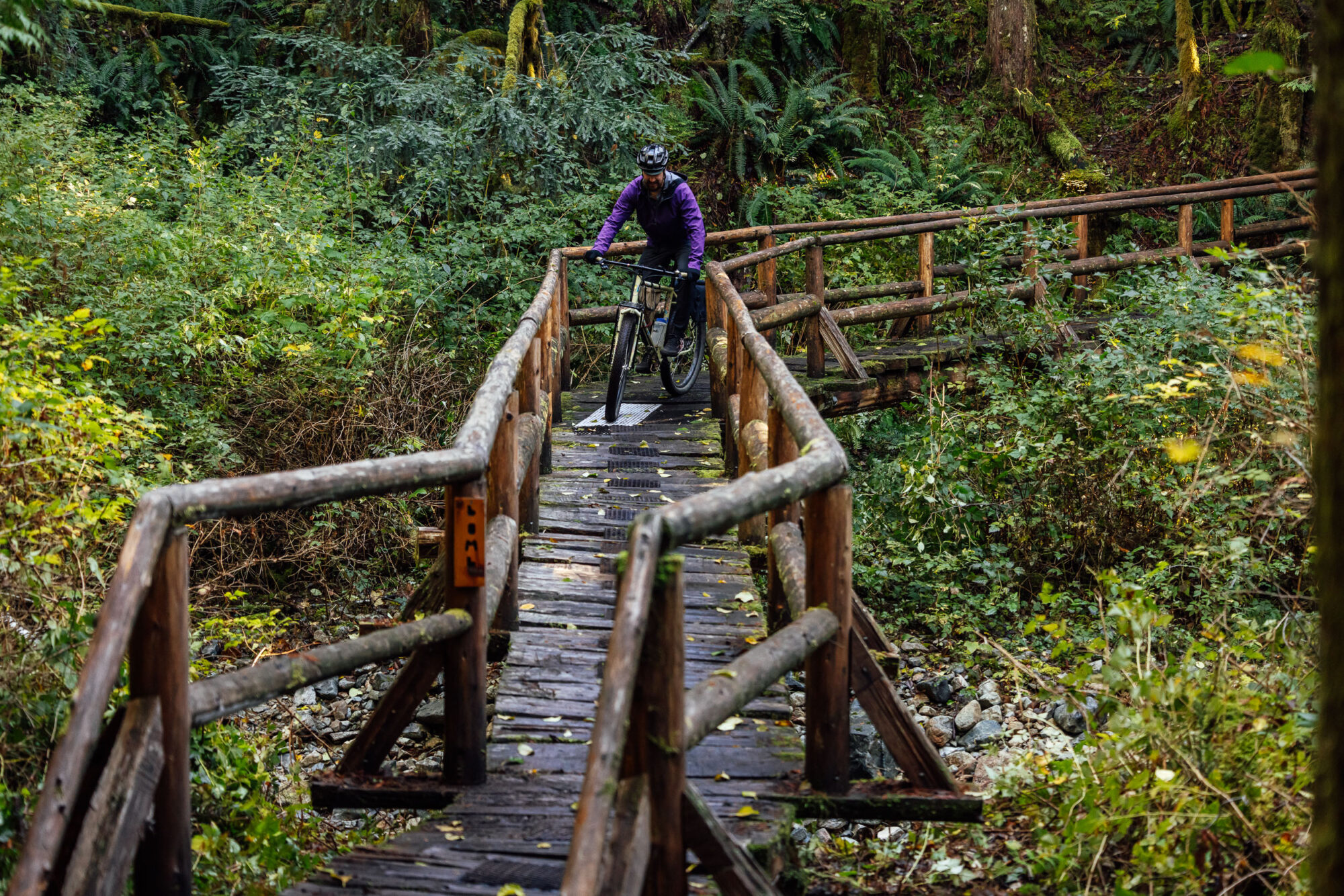
Although the latest Scapegoat has internal seat tube dropper post routing, rest assured every other cable and hose is externally routed. When the robots are taking control and everyone’s T-type derailleurs have turned against us, you’ll be peacefully changing your cables by the side of the trail. The full-housing rear brake and derailleur cables all run neatly under the downtube and follow a series of tightly positioned braze-on guides. Even with the extra-long cables Crust sent the bike with (thank you!), nothing gets in the way of bags or snags on branches.
Alt-Terrain Bikepacking
The Scapegoat has been my go-to ATB for the better part of 2023. It’s been my commuter, errand-runner, exploration tool, and bikepacking rig. The Scapegoat excels at carrying heavy loads and checking out new terrain. Its geometry, mounting capability, and front-loading-friendly angles lend themselves perfectly to any bikepacking route that requires lots of gear, and, perhaps more importantly, no sense of urgency.
While the high bottom bracket and steeper front end may be off-putting for die-hard trail riders, loading the Scapegoat up with gear offsets these qualities and contributes to its overall stability and traction. The high bottom bracket feels tippy without gear, but with bags and weight, it’s easier to lean the bike and maintain traction, especially in low-speed tech. The same can be said for the short/steep front end, a combination that feels twitchy without weight but slows down with it. Unloaded, the Scapegoat is surprisingly playful once it gets up to speed. Nick Kuszyk’s impression of how it rides is perfect: “I love that it feels zippy. I get stoked and try to pull it on a jump, and it’s like, oh no, we’re too heavy to leave the ground very far… calm down.”

Slow and steady is the name of the game for long, steep climbs. The shorter front end forced me to stay seated and spin away, and I was rarely tempted to get out of my saddle to speed up. If your resolution is to slow down for 2024, then the Scapegoat is the golden ticket.
Pros
- Purpose-built for heavy loads, lots of weight up front, and expedition-style bikepacking.
- Clearance for 29+ tires across all sizes.
- Many specs we appreciate, including sliding dropouts, thru-axles, boost hub spacing, external cables, and dropper post routing.
- Relaxed, upright position is perfect for multi-day riding.
- RRobots graphics and design input fit the Scapegoat philosophy.
- Short reach would likely work well for drop bars in some cases.
- Massive main triangle.
Cons
- Steep head tube angle and short reach might not work for everyone and are somewhat limiting on steep terrain.
- Slightly heavier than other 29+ rigid steel bikes, but steel 29+ ain’t ever light.
- Unloaded, the handling feels twitchy. Toss a rack and some mini panniers on!
- High bottom bracket and 29+ tires makes for a high, tippy perch. Stability is improved with weight.
- 29 x 3.0” tire clearance doesn’t quite fit in the shortest rear dropout position.
- More expensive than a Surly or Salsa, but more affordable than a Tumbleweed.
- Model/Size Tested: Crust Scapegoat “ScapeBot”/XL
- Actual Weight (as tested): 30.5 pounds (13.8 kilograms)
- Place of Manufacture: Taiwan
- Price (Frameset): $1,175 USD
- Manufacturer’s Details: Crust Bikes
Wrap Up
Compared to the most popular plus-sized rigid mountain bikes, the Scapegoat ScapeBot is something of an outlier. While other rigid bikes have slowly gotten longer, slacker, lower, and more rowdy, the Scapegoat has settled into a form that’s more in line with its original inspiration. It’s far less common to see bikes getting shorter and less slack–the Benjamin Buttons of the rigid mountain bike world—but that’s exactly what happened with the Crust Scapegoat ScapeBot.
Rather than competing with the influx of big-tired, rowdy hardtails, Crust revisited the original rationale for the Scapegoat and honed in on it. The geometry changes make for a functional front-loading champion. It’s the epitome of a modern rigid mountain tourer and is perfect for anyone who likes to absorb everything around them, move slowly, and carry everything and anything they might need along the way. It might not be my first choice for technical singletrack, but for chunky dirt roads and expedition-style bikepacking trips, the Scapegoat gets my nod of approval.

Do you enjoy our in-depth reviews, route guides, and stories? We’re a small, independent publication dedicated to keeping our content free for everyone, but we need your support. To keep articles like this one coming (and not behind a firewall), please consider becoming a member of our Bikepacking Collective. By joining, you’ll receive The Bikepacking Journal in the mail twice a year, industry discounts, and many other great benefits. Learn more here.
Further Reading
Make sure to dig into these related articles for more info...
Please keep the conversation civil, constructive, and inclusive, or your comment will be removed.






